Outcome-Based Performance
An energy-efficient building design doesn't always translate into a high performance building. Attention to energy performance outcomes ensures savings are realized.
Read Our Getting to Outcomes Summit Report
Read NowCode & Policy
Outcome-Based Energy Codes (Advanced Codes)
Codes & Policy / December 21, 2015
Our nation’s current energy codes include structural and enforcement characteristics that limit the ability to achieve significantly more energy savings without major changes. Current energy code strategies consider only a limited number of the factors that impact building energy performance. ...
Steps to Achieving Outcome-Based Energy Codes
Codes & Policy / December 22, 2015
Outcome-based energy codes, codes require that a number of policy, data and administration pieces be put in place.
Tools & Guides
Research
Sensitivity Analysis: Comparing the Impact of Design, Operation, and Tenant Behavior on Building Energy Performance
Report / July 27, 2011
This study compares the magnitude of energy impact that various design features, operations and tenant behaviors have on total building energy use. The findings of this study can help the building community begin to align their priorities with those building…
High Performance Buildings Measured Performance and Key Performance Indicators
Report / April 24, 2013
This Final Research Summary Report summarizes the findings for the High Performance Buildings Measured Performance and Key Performance Indicators project within the Evidence-based Design and Operation research program.
Outcome-Based Performance Summit Summary
Report / September 12, 2014
Attention to achieving desired performance goals, particularly for energy use, through outcome-based requirements is growing. Given the numerous factors that influence actual performance (design, operations, climate, occupancy, etc.) and the traditional delivery pathways, important questions have been raised about how…
Focused Strategies
There are no codes & policy for Outcome-Based Performance. Please see our other codes & policy below.
2024 IECC Code Change Proposal Synopsis
Codes & Policy / February 14, 2022
Below you will find summaries of the draft code amendments and links to revision details that were submitted by NBI into the ICC process to advance the 2024 IECC. They are identified as Commercial or Residential and categorized by efficiency,...
Embodied Carbon
Codes & Policy / February 13, 2022
Building operations and construction-related activities are responsible for approximately 39% of humanity‘s global greenhouse gas (GHG) emissions. More than a fourth of those are embodied carbon emissions, those associated with the production of building materials, construction activities, operations, and end...
Building Performance Standards
Codes & Policy / January 21, 2022
Building performance standards (BPS) set targets for existing building energy performance and are one of the best tools we have for achieving deep energy savings and emissions reductions in existing buildings. They can be written to optimize the energy use...
Model and Base Energy Codes
Codes & Policy / July 16, 2021 / Energy Codes
For more than 20 years, NBI has been working with partners and within the code-making bodies to advance codes at the national, state, and local government levels. National model energy codes and standards like ASHRAE 90.1 and the International Energy Conservation Code (IECC) have...
Zero Cities Project
Codes & Policy / February 13, 2019 / Energy Codes
The Zero Cities Project is a three-year project supporting both cities and their most impacted communities* to co-develop and implement actionable and equitable roadmaps and policy strategies to achieve a zero-net-carbon (ZNC) building sector by 2050. Through a community collaboration...
Zero Energy/Carbon Codes
Codes & Policy / October 28, 2018 / Zero Net Energy (ZNE)
Building energy codes are playing an increasing in facilitating the move to ZE buildings. As advances in construction practices and building components and systems are proven out, communities are strengthening the building codes so that higher levels of building efficiency...
Stretch Codes (Advanced Codes)
Codes & Policy / October 15, 2018 / Energy Codes
New design and process strategies can be demonstrated through a variety of advanced code strategies. NBI builds market capacity for higher efficiency energy codes by encouraging the use of stretch codes (also referred to as reach codes). To support the...
Washington State Energy Code Roadmap to 2031
Codes & Policy / October 15, 2018 / Energy Codes
Many organizations and jurisdictions have adopted a range of building performance goals over the past decade that have significantly changed the conversation about energy codes and building energy performance. The primary policy driver for the Washington State Energy Code increases in...
Steps to Achieving Outcome-Based Energy Codes
Codes & Policy / December 22, 2015
Outcome-based energy codes, codes require that a number of policy, data and administration pieces be put in place.
zEPI
Codes & Policy / December 22, 2015
The 2015 International Green Construction Code (IgCC) includes many progressive measures that will improve the energy performance of buildings. One important provision describes the Zero Energy Performance Index (zEPI), which provides a scale for measuring commercial building energy performance. zEPI...
Zero Net Energy Policies
Codes & Policy / December 22, 2015
Policies and programs can dramatically change the landscape for Zero Net Energy (ZNE) buildings. There is burgeoning market interest in ZNE, and policies and programs can foster and grow that interest through leadership, direct support, and the reduction of risks and...
Aligning Utility Programs with Local Codes (Policy)
Codes & Policy / December 22, 2015
Bringing energy codes to market often involves a comprehensive approach that starts years before a code is adopted by a local jurisdiction. NBI provides technical assistance through each stage of code development. NBI aggregates technical information from existing high performance buildings. Observed trends...
Outcome-Based Energy Codes (Advanced Codes)
Codes & Policy / December 21, 2015
Our nation’s current energy codes include structural and enforcement characteristics that limit the ability to achieve significantly more energy savings without major changes. Current energy code strategies consider only a limited number of the factors that impact building energy performance. ...
Model Energy & Green Codes
Codes & Policy / December 19, 2015
NBI works collaboratively with a wide range of industry partners to bring model energy codes up to current market capabilities. Measures promoted by NBI include higher efficiency standards for equipment and advanced design strategies such as daylighting. Once adopted by states...
COMNET (Polcy)
Codes & Policy / December 19, 2015 / Policy
NBI manages the development of COMNET, a quality assurance initiative to standardize building energy modeling, by creating consistent baselines relative to various energy codes and standards. COMNET extends and supports existing systems for assessing and rating the energy efficiency of...
ResearchView All
There is no research for Outcome-Based Performance. Please see our other research below.
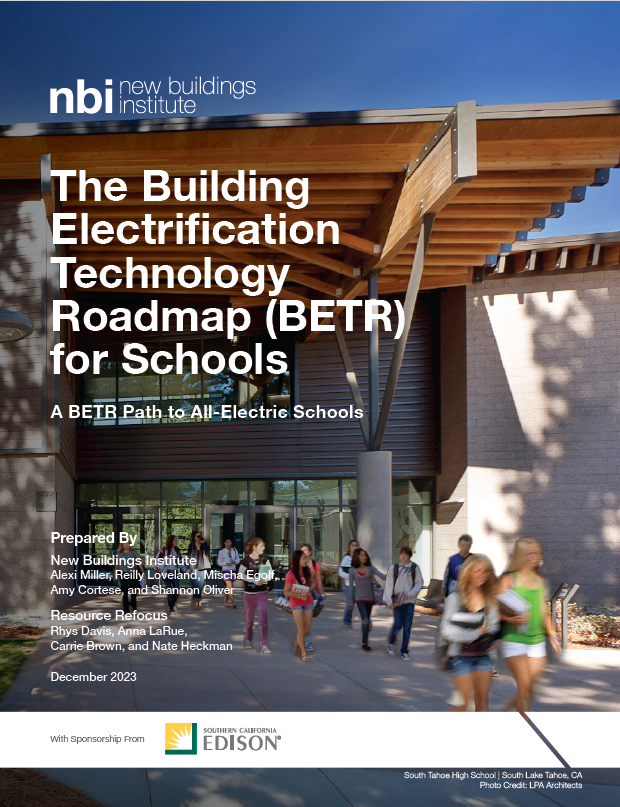
The Building Electrification Technology Roadmap for Schools
Report / January 29, 2024
Learn strategies tailored for K-12 schools to reduce carbon emissions from water heating, HVAC, buses, and other technologies that power classrooms and operational spaces. This report provides K-12 leaders a roadmap and decision-making tools to electrify their school buildings.
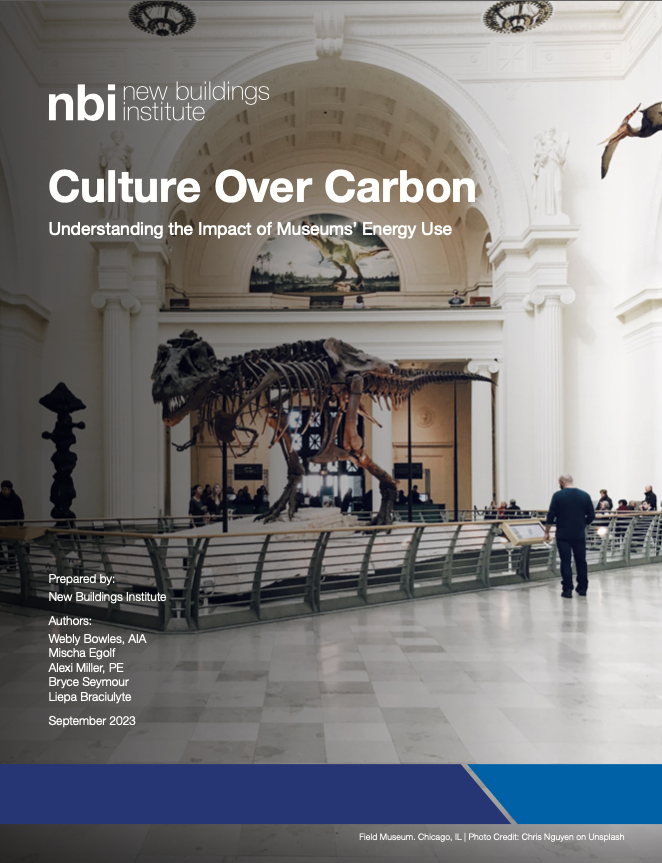
Culture Over Carbon
Report / September 7, 2023
The Culture Over Carbon report shares the first in depth review of energy use patterns in cultural institutions across the United States and creates a roadmap for energy reductions based on best practices from this sector. Cultural institutions play a…
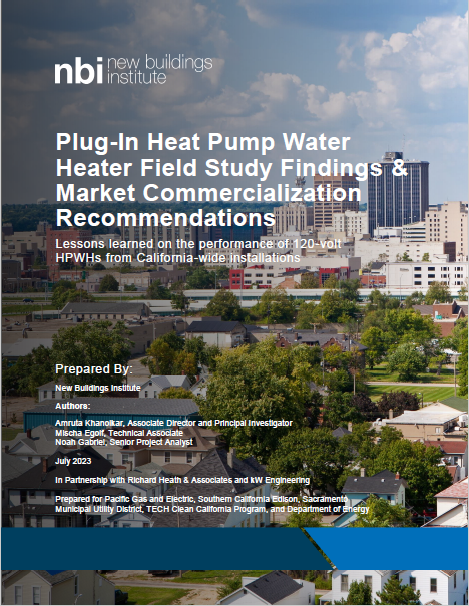
Plug-In heat Pump Water Heater Field Study Findings & Market Commercialization Recommendations
Report / July 12, 2023
Water heating and space heating together account for two thirds of residential energy usage in the U.S. and should be the cornerstones of any plan to decarbonize the built environment. Emerging, plug-in 120-volt heat pump water heaters (HPWHs) are entering…
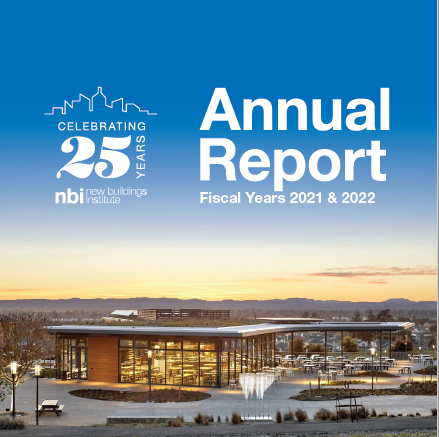
Annual Report 2021 & 2022
Report / January 19, 2023
In 2022, NBI celebrated 25 years of working collaboratively with industry market actors to promote advanced design practices, innovative technologies, public policies, and programs that improve energy efficiency and reduce emissions from the built environment. Our dedicated team of staff,…
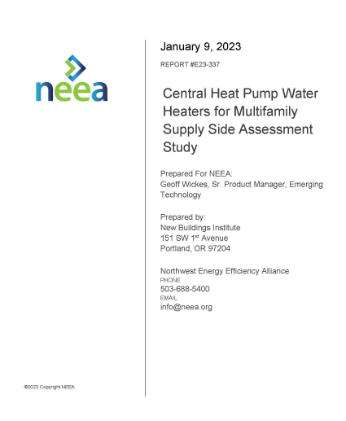
Central Heat Pump Water Heaters for Multifamily Supply Side Assessment Study
Report / January 10, 2023
The Northwest Energy Efficiency Alliance (NEEA) contracted with New Buildings Institute (NBI) in January 2021 to conduct research and outreach to better understand the current landscape of central heat pump water heater (HPWH) adoption in multifamily buildings. Research objectives included…
Carbon Neutral Schools Customizable Templates
Document / April 25, 2022
To accompany the Decarbonization Roadmap Guide, a number of templates have been developed for school districts to customize to their needs in their efforts to decarbonize Carbon Neutral Schools Resolution Template The Carbon Neutral Schools Resolution Template provides a starting…
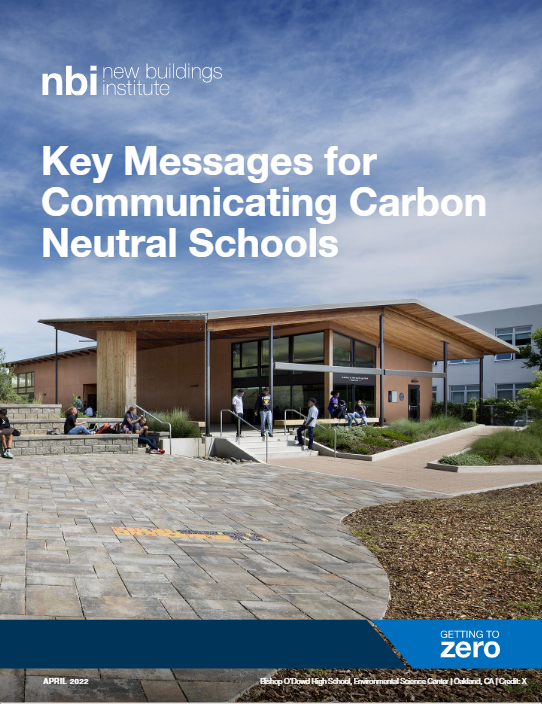
Key Messages for Communicating About Carbon Neutral Schools
Document / April 25, 2022
Effective communication is critical to successfully engage your audience and ultimately achieve your goal of designing, constructing, and operating a zero energy (ZE) school. This document will help you to address key questions around your communication effort and engage stakeholders…

Cost Study of the Building Decarbonization Code
Report / April 13, 2022
This “Cost Study of the Building Decarbonization Code” analyzes the incremental first cost and life cycle cost of two common building types that follow the code language in NBI’s Building Decarbonization Code. The study, which was supported by the Natural…
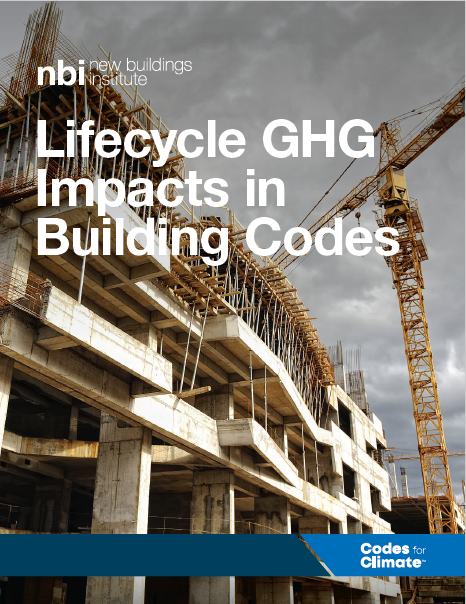
Lifecycle GHG Impacts in Building Codes
Report / January 18, 2022
NBI’s report presents language to incorporate embodied carbon requirements in building codes. Researchers explain the need to address the embodied carbon of the highest emitting materials and the carbon emission benefits for jurisdictions. This report examines the current lack of…
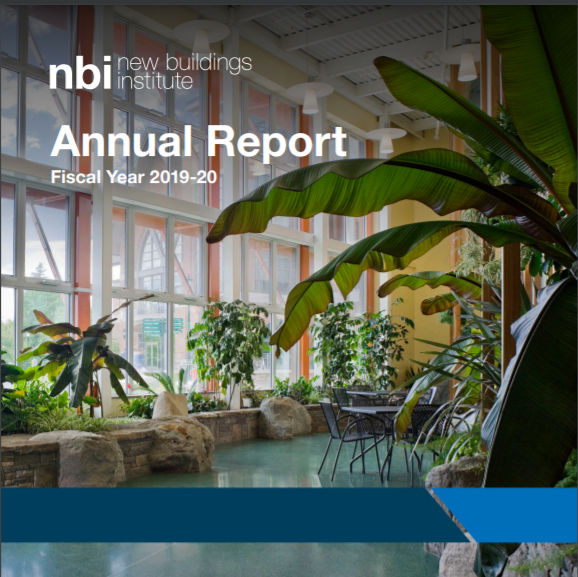
Annual Report 2019-2020
Report / December 17, 2021
NBI is approaching 25 years of commitment to better energy performance in buildings as a way to save energy and money, create more comfortable living and work spaces for all, and now, to urgently decarbonize the built environment in order…
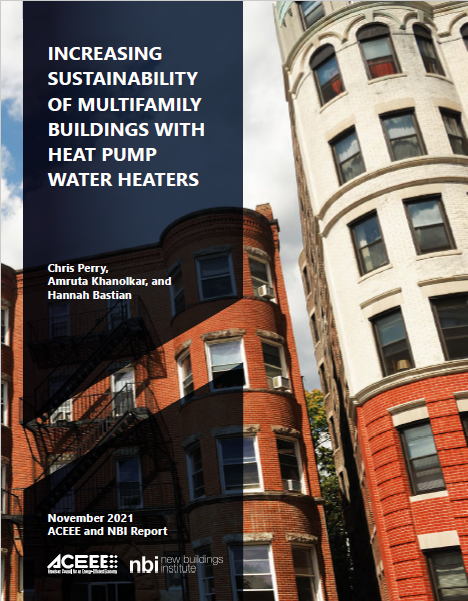
Increasing Sustainability of Multifamily Buildings with Heat Pump Water Heaters
Report / November 18, 2021
From four-unit townhomes to large complexes, multifamily buildings use a significant amount of energy to provide hot water to their occupants. Much of that hot water is provided by natural gas and other fossil fuels, which emit harmful greenhouse gases…
The GridOptimal Buildings Initiative
Paper / October 26, 2021
The role of buildings, renewable energy, and energy storage in the utility industry is changing. New near-term solutions are needed to address today’s challenges and capitalize on opportunities for market transformation. New Buildings Institute, in partnership with the U.S. Green…
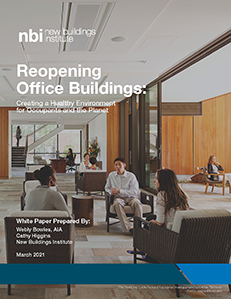
Reopening Office Buildings: Creating a Healthy Environment for Occupants and the Planet
Paper / June 27, 2021
This white paper provides an overview and summary of the multiple building systems that affect occupants’ return to a safe indoor air environment, their energy use implications, and recommendations for best practices. Included is Retrofit and Reopening Recommendations for Offices—a…
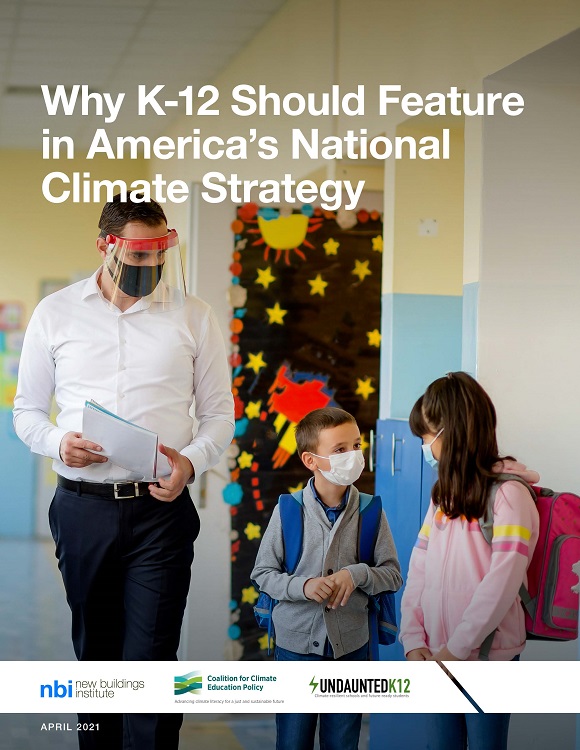
Why K-12 Should Feature in America’s National Climate Strategy
Paper / April 21, 2021
This white paper by UndauntedK12, New Buildings Institute, and the Coalition for Climate Education Policy offers a national perspective on the urgent role that our K-12 sector must play in our national climate strategy. In particular, we urge state and…
The Technical Basis of Building Performance Standards
Paper / March 19, 2021
As leading cities and states seek to meet their aggressive climate, energy, and decarbonization goals, they are turning increasingly to mandatory policies that require improved energy and emissions performance across their existing building stock. The most comprehensive of these policies…
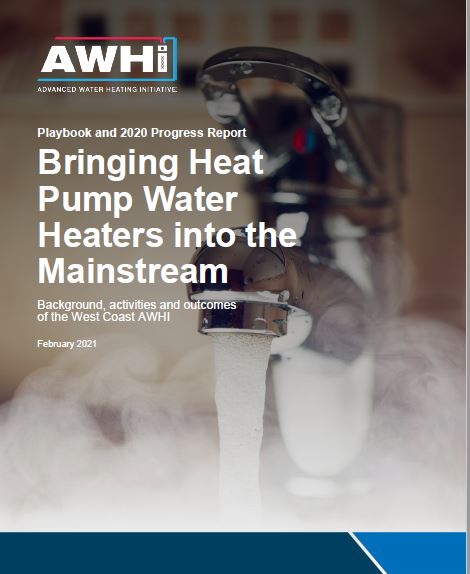
Bringing Heat Pump Water Heaters into the Mainstream
Report / February 10, 2021
The Advanced Water Heating Initiative (AWHI) Playbook and 2020 Progress Report summarizes the activities of AWHI through the end of 2020. The West Coast AWHI has made tremendous progress in the two years it has been underway. The Initiative includes…
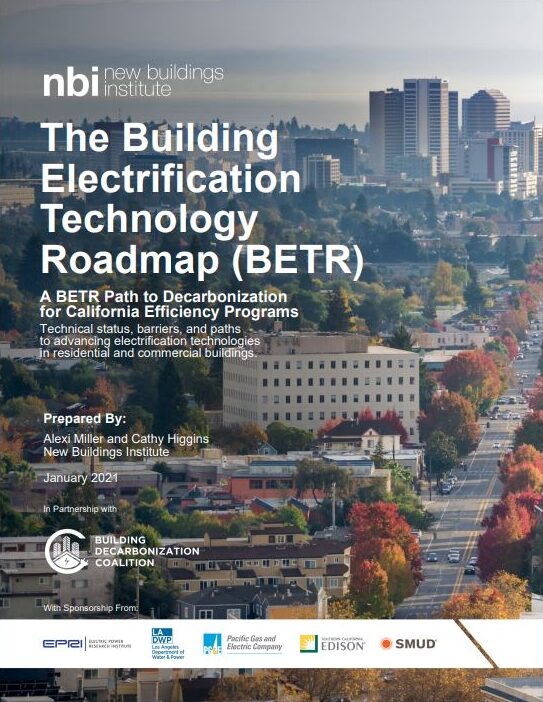
Building Electrification Technology Roadmap
Paper / January 12, 2021
The Building Electrification Technology Roadmap (BETR) is a guide for utilities and other organizations developing, implementing, and supporting electrification technology programs as a way to advance high efficiency technologies, reduce GHG emissions, and improve public health. It’s the first study…
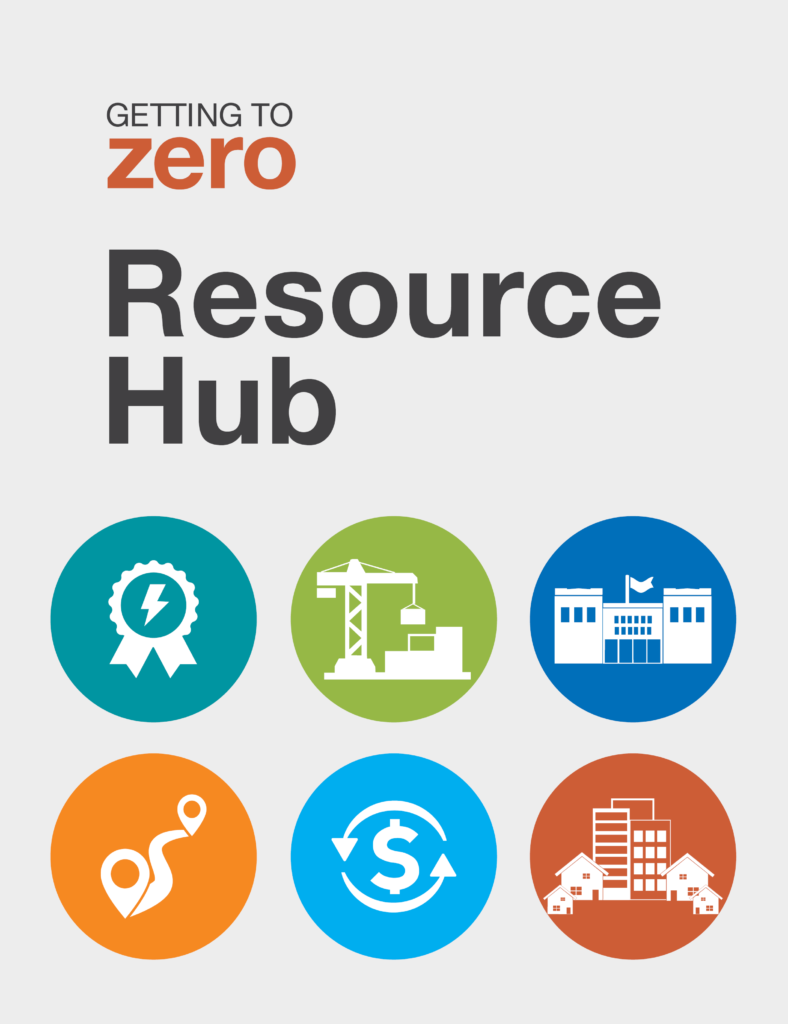
Getting to Zero Resource Hub
Document / January 8, 2021
The Getting to Zero Resource Hub is home to over 300 resources on zero energy and carbon neutral buildings including guides, models, research, case studies, educational webinars, and more. Categories cover design and development, codes and policy, residential buildings, embodied…

2020 Midwest Getting to Zero Buildings List
Document / October 22, 2020
The 2020 Midwest Getting to Zero Buildings List tracks commercial and multifamily zero energy (ZE) building projects across 13 states, including: Illinois, Indiana, Iowa, Kansas, Kentucky, Michigan, Minnesota, Missouri, Nebraska, North Dakota, Ohio, South Dakota, and Wisconsin. This inaugural Buildings…
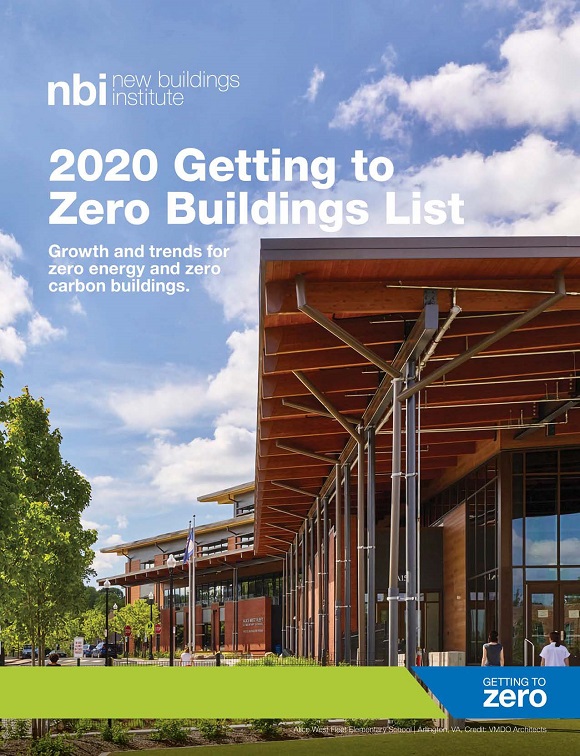
Getting to Zero Buildings Lists
Document / September 24, 2020
NBI's 2020 list of pioneering zero energy (ZE) projects represents the latest growth in a rapidly expanding market. For this list, ZE buildings are extremely energy efficient, with a median site EUI of only 23 kBtu/sf/yr*, and consume only as…

GridOptimal Phase 2 Outcomes
Report / July 19, 2020
The role of buildings, renewable energy, and energy storage in the utility sector is changing. New near-term solutions are needed to address today’s challenges and capitalize on opportunities for market transformation. New Buildings Institute (NBI), in partnership with the U.S.…
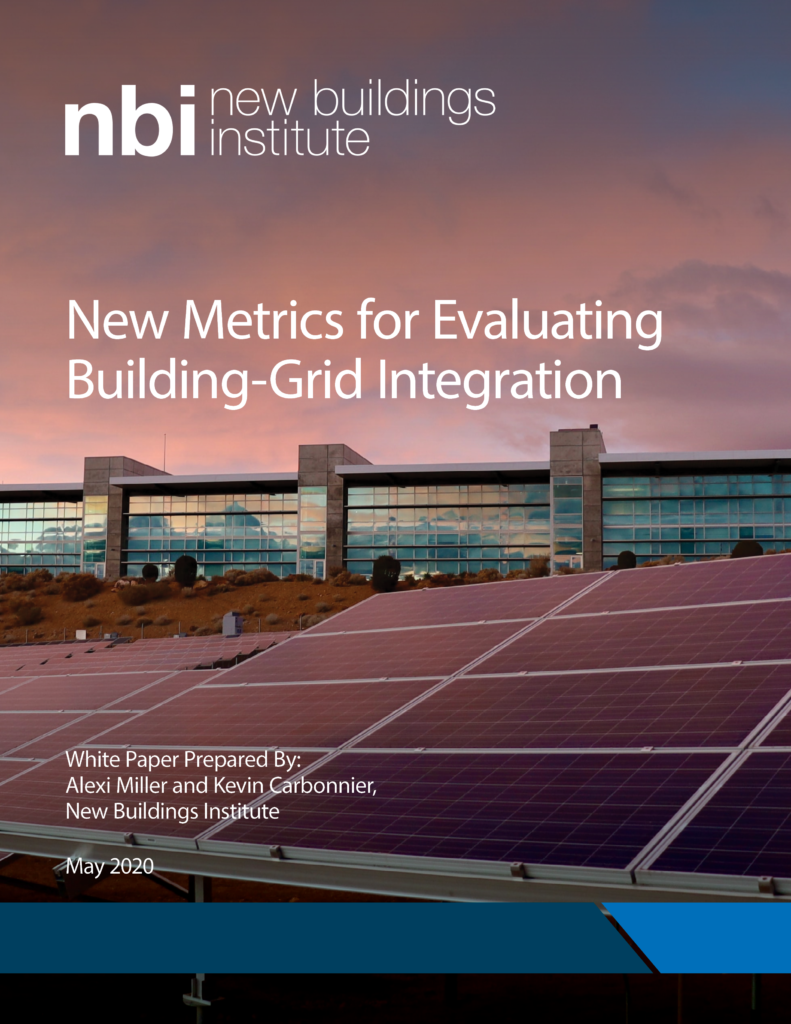
New Metrics for Evaluating Building-Grid Integration
Paper / May 18, 2020
Since mid-2018, the not-for-profit, multi-stakeholder GridOptimal Buildings Initiative (GridOptimal 2020) has been developing metrics to measure the grid impacts of building features and operating characteristics to support a new design approach that prioritizes better building-grid integration across the building stock.…
Taking the (Fuel) Blinders off Energy Codes Part 2: Metrics and Mechanics in the Modern Era
Paper / March 26, 2020
This paper follows upon a recently published paper examining how climate policy now impacts energy code policy. A variety of drivers, including greenhouse gas emission goals, regulation, market forces, and new technologies, is changing the relationship between buildings and the…
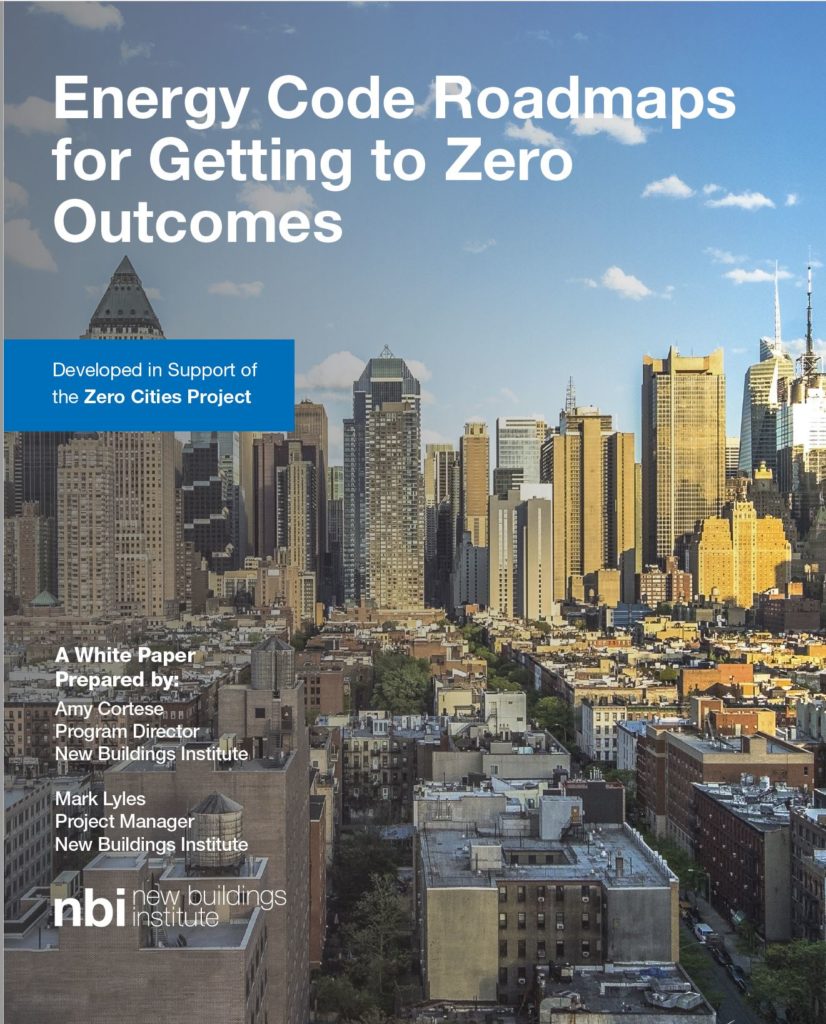
Energy Code Roadmaps for Getting to Zero Outcomes
Paper / February 20, 2020
Advanced energy codes are an important policy mechanism to advance energy efficiency and integrate renewables into the built environment. Energy code roadmaps lay the groundwork by identifying the order and priorities necessary for subsequent code improvements on the path to…
Putting Data to Work: Using Monthly Data From Benchmarking Programs
Report / January 27, 2020
This guide from the Institute for Market Transformation (IMT) provides an overview of the powerful ways in which monthly building consumption data can yield new insights, and how these insights can help cities to design more effective targeted programs.
NBI’s December Newsletter
Document / January 14, 2020
Read our December 2019 newsletter for a variety of energy related news, including: 2021 IECC, San Jose’s Reach Codes, NBI Fellows, Zero Carbon buildings, Passive House, California's ZNE Leadership Award winners, a new White Paper on Zero Energy Performance Targets,…
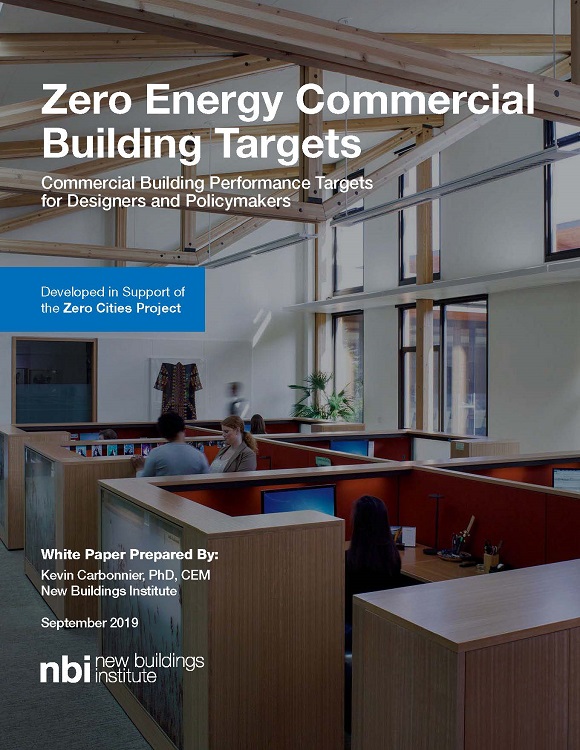
Zero Energy Commercial Building Targets
Paper / September 9, 2019
The critical first step in achieving a zero energy building is to set an energy use target. This Zero Energy Commercial Building Targets white paper helps define appropriate goals for these ultra-low energy buildings, which often surpass even the most…
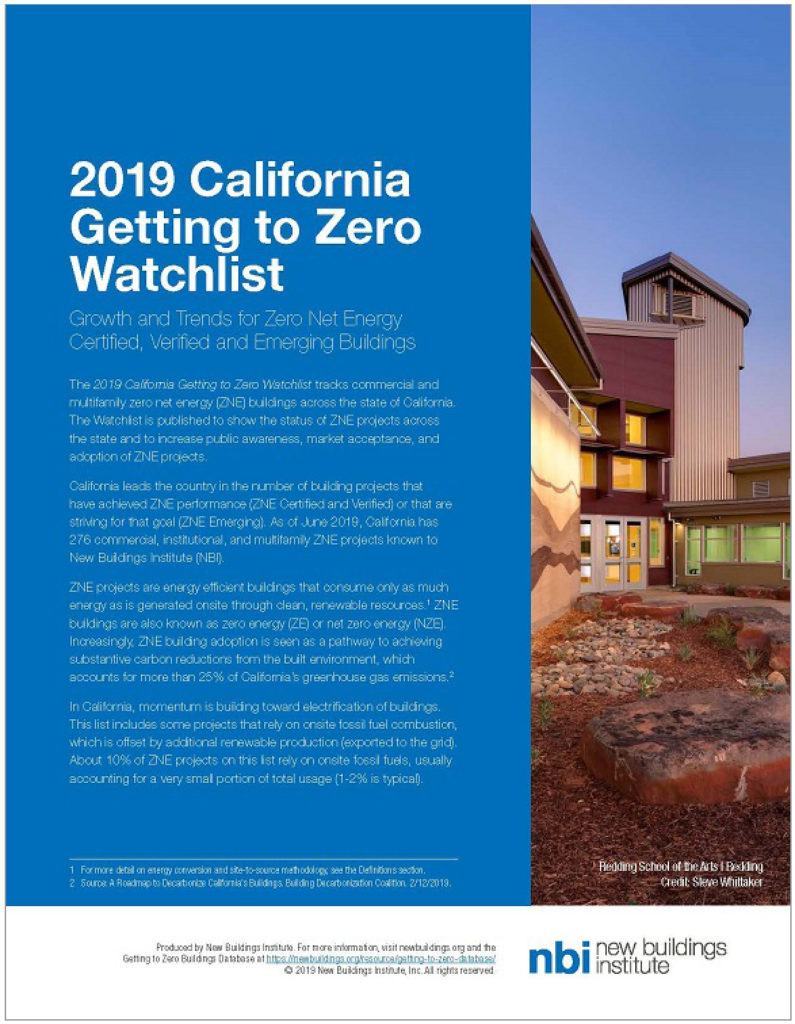
California Getting to Zero Watchlists
Document / August 29, 2019
NBI uses its extensive buildings data set to develop specialized Buildings Lists focused on a particular region or building type to help increase public awareness, market acceptance, and adoption of zero energy projects. California leads in zero energy buildings and…
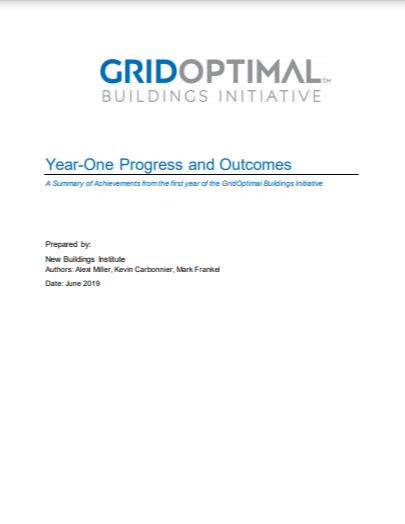
GridOptimal Phase 1 Outcomes
Document / June 19, 2019
The role of buildings, renewable energy, and energy storage in the utility sector is changing. New near-term solutions are needed to address today’s challenges and capitalize on opportunities for market transformation. New Buildings Institute (NBI), in partnership with the U.S.…
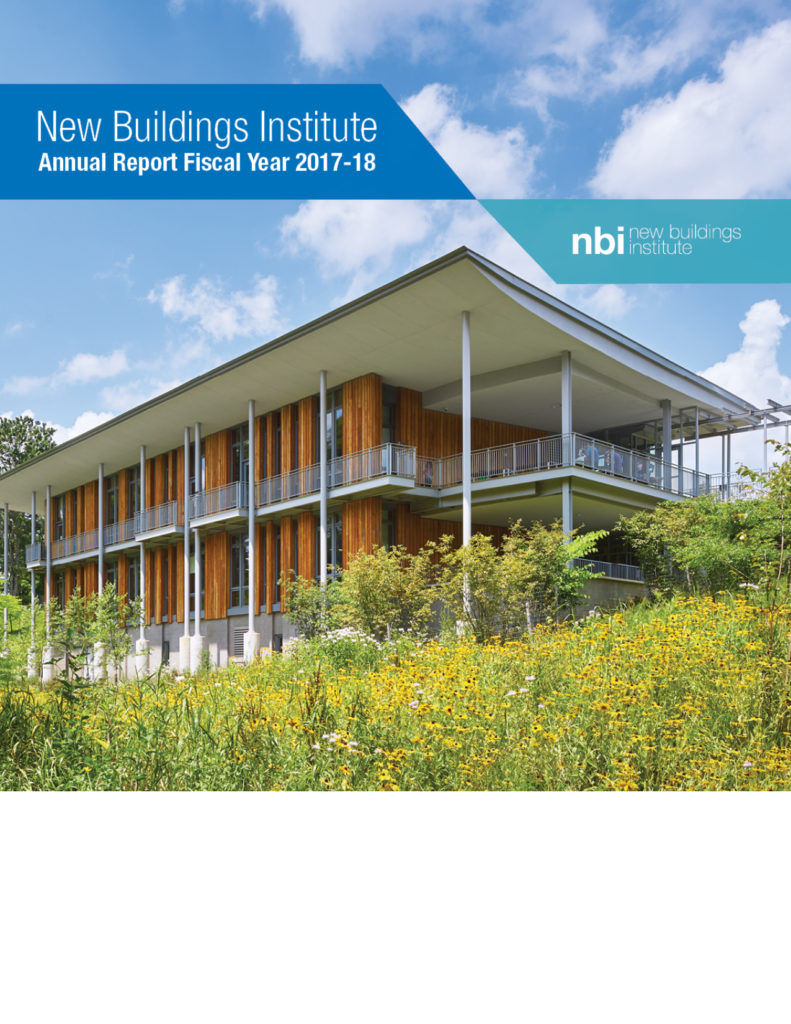
Annual Report 2017-2018
Report / June 11, 2019
In 2017, NBI celebrated its 20th anniversary marking steadfast progress in achieving market transformation toward improved energy efficiency in the built environment. Our founders envisioned a new organization that would be dedicated to advancing codes, conducting research, and developing guidance…
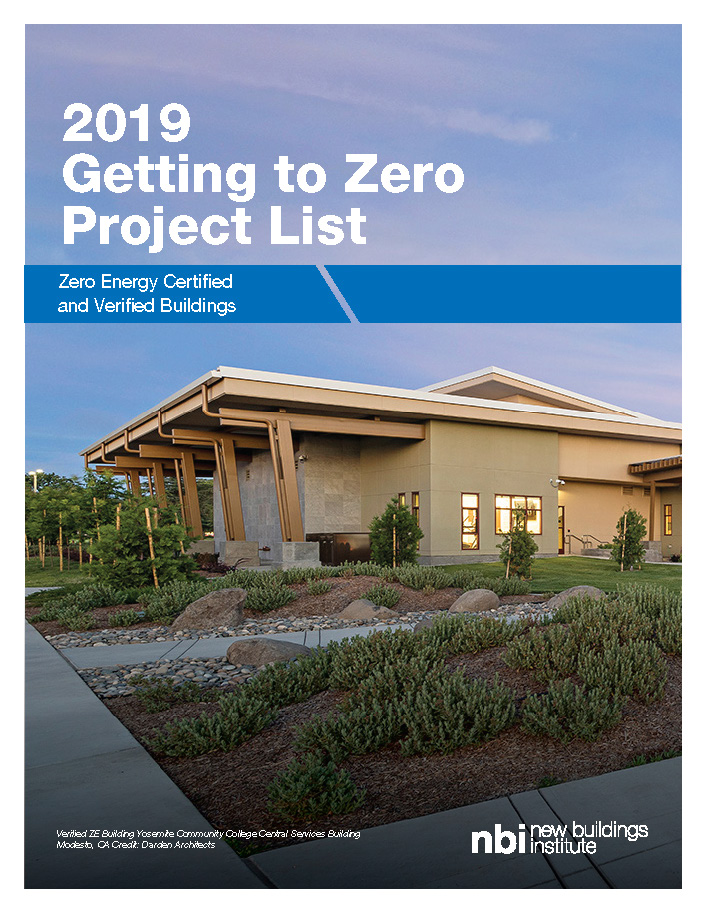
2019 Getting to Zero Project List
Document / May 8, 2019
The 2019 Getting to Zero Project List tracks commercial and multifamily zero energy (ZE) projects across North America where ZE performance has been certified by a third party or verified by NBI. The trailblazing projects in this list have achieved…
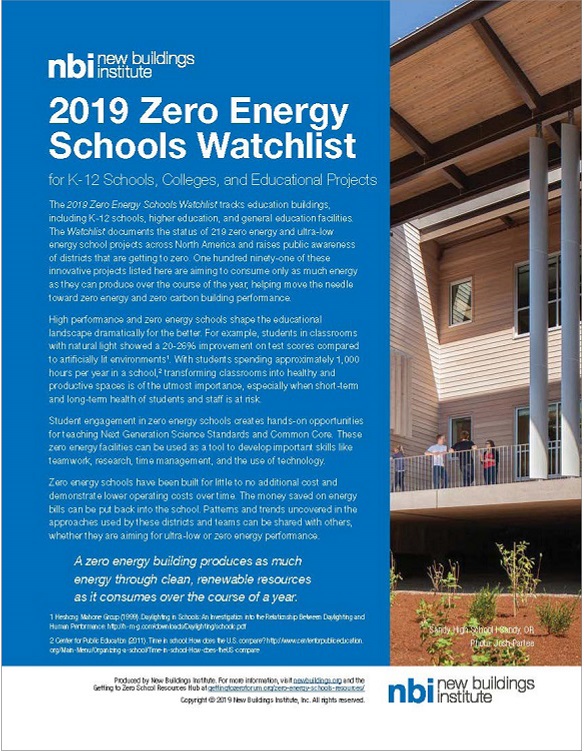
2019 Zero Energy Schools Watchlist
Document / April 24, 2019
The 2019 Zero Energy Schools Watchlist tracks education buildings, including K-12 schools, higher education, and general education facilities. The Watchlist documents the status of zero energy school projects across North America and raises public awareness of districts that are getting…
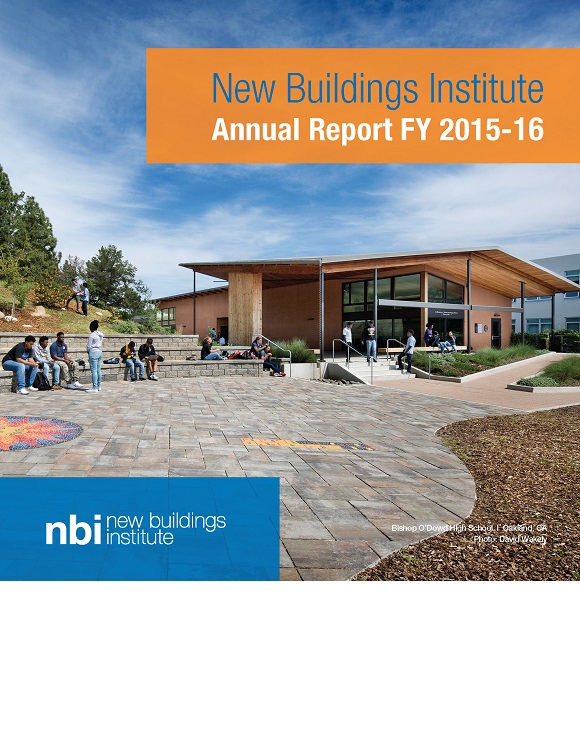
Annual Report FY 2015-2016
Report / April 16, 2019
Increasing building energy efficiency is a process that we at New Buildings Institute have been active in for nearly 20 years. Whether driven by policy mandates, a corporate resolution, or by innovative engineers and architects striving for a better end…
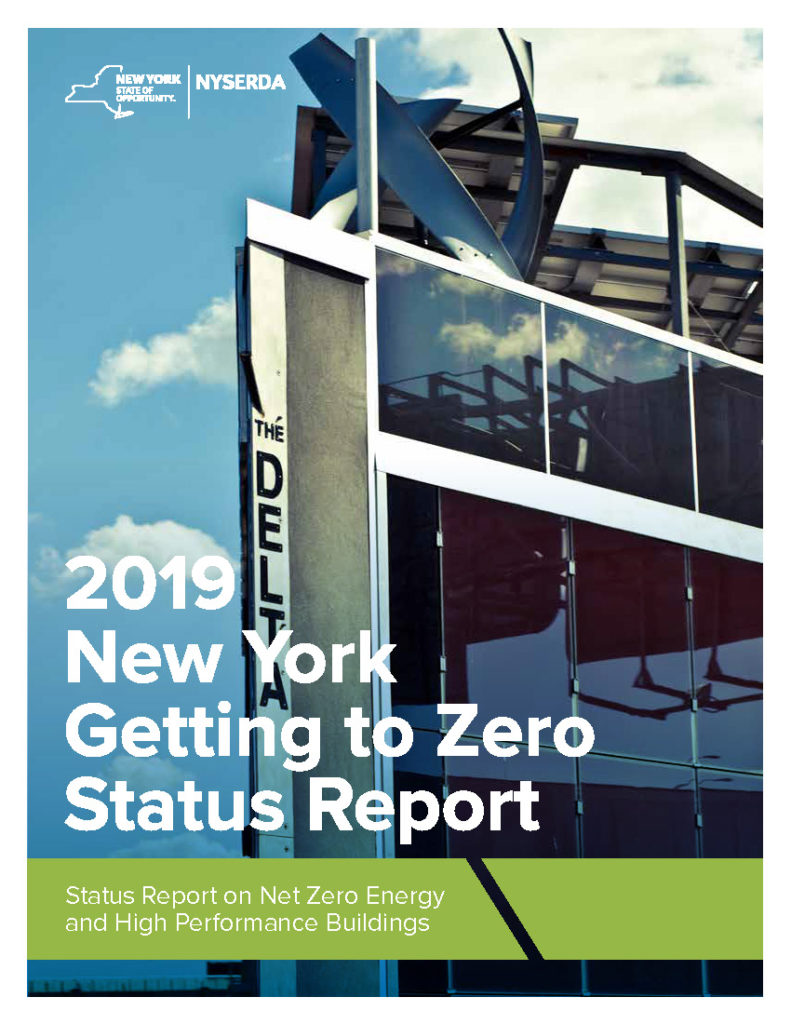
2019 New York Getting to Zero Status Report
Report / April 15, 2019 / Zero Net Energy (ZNE)
The 2019 New York Getting to Zero Status Report is a first-of-its-kind review of the state of the net zero energy buildings market in New York State and provides detailed policy and market context about New York’s leading role in…

2019 Zero Energy Schools Watchlist
Document / February 13, 2019
The 2019 Zero Energy Schools Watchlist tracks education buildings, including K-12 schools, higher education, and general education facilities. The Watchlist documents the status of zero energy school projects across North America and raises public awareness of districts that are getting…
Northwest Zero Energy Watchlist
Document / December 19, 2018
The Northwest Zero Energy Watchlist tracks commercial and multifamily zero energy (ZE) buildings across the states of Washington, Oregon, Idaho and Montana. The Watchlist is published to show the status of ZE projects in the region and to increase public…
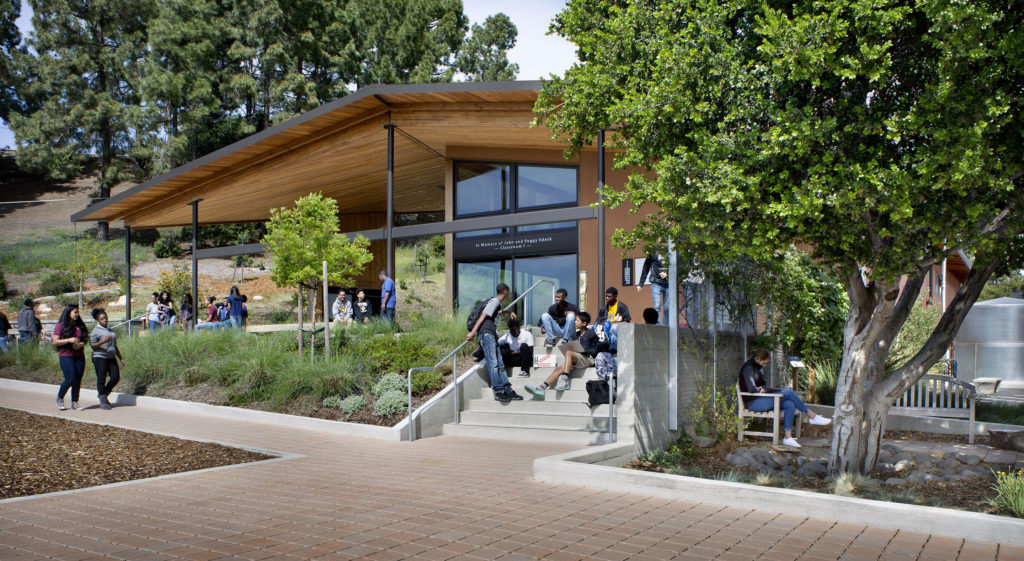
Zeroing in on Schools
Paper / August 27, 2018
This paper from the 2018 ACEEE Summer Study presents completed national research about decision-making, funding and energy practices in the K-12 schools new and existing buildings market. The paper confirms the obvious, that educational outcomes and student performance are the…
Energy Efficiency Savings Up in Smoke: The Budding Impact of Indoor Agriculture and Cannabis Production
Document / August 27, 2018
This poster was presented by NBI staff at the 2018 ACEEE Summer Study. Indoor horticulture energy usage is projected to grow substantially over the next several years, driven in large part by the legalization of medical and recreational cannabis. How…
Radiant Solutions: Energy Findings from the Largest Study of Commercial Buildings with Radiant Cooling and Heating System
Document / August 27, 2018
This poster about energy efficiency advantages of radiant cooling was presented by NBI staff at the 2018 ACEEE Summer Study. Buildings with radiant cooling have similar comfort and use less energy. Learn more about how with this resource.
Stretch Codes on the Road to Zero Energy – Potholes and Speed Traps Ahead
Paper / August 27, 2018
This paper details how a range of stretch code efforts, working in parallel, contribute to the overall progress in energy savings, with many current stretch codes targeting 20% energy savings from ASHRAE 90.1-2013/2015 IECC. It also explores how stretch codes…
Taking the (Fuel) Blinders off Energy Codes
Paper / August 27, 2018
Amidst a backdrop of the Arab Oil Embargo of 1973 and a perception of physical limits on energy resources, the obvious policy imperative of a new generation of energy codes was to reduce the use of all types of energy.…
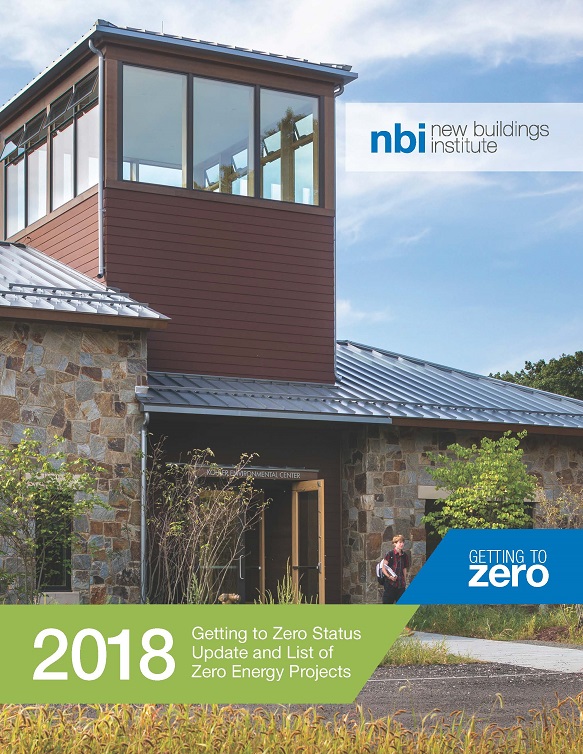
2018 Getting to Zero Status Update
Report / January 23, 2018
We are pleased to share the 2018 Getting to Zero Status Update and Zero Energy Buildings List, which summarizes the growth and trends from nearly 500 certified, verified and emerging zero energy projects across the United States and Canada. In…
California K-12 and Community College Zero Net Energy Retrofit Readiness Study
Report / November 17, 2017
The California K-12 and Community College Zero Net Energy (ZNE) Retrofit Readiness Study provides recommendations to California Program Administrators and other key market actors on how to best stimulate and enable the public school market to meet California’s aggressive ZNE…
Energy Performance of Commercial Buildings with Radiant Heating and Cooling
Report / August 10, 2017 / HVAC
This report is part of the California Energy Commission (CEC) EPIC project (EPIC-14-009), Optimizing Radiant Systems for Energy Efficiency and Comfort. The main goal of this research was to determine the building characteristics of projects with radiant heating and cooling…
Federal Preemption as a Barrier to Cost Savings and High Performance Buildings in Local Energy Codes
Paper / June 22, 2017
This white paper from New Buildings Institute (NBI) looks at the impacts of federal rules on efficiency standards for appliances, water heating and HVAC equipment and lays out possible solutions from an examination of policies from around the world. Decades-old…
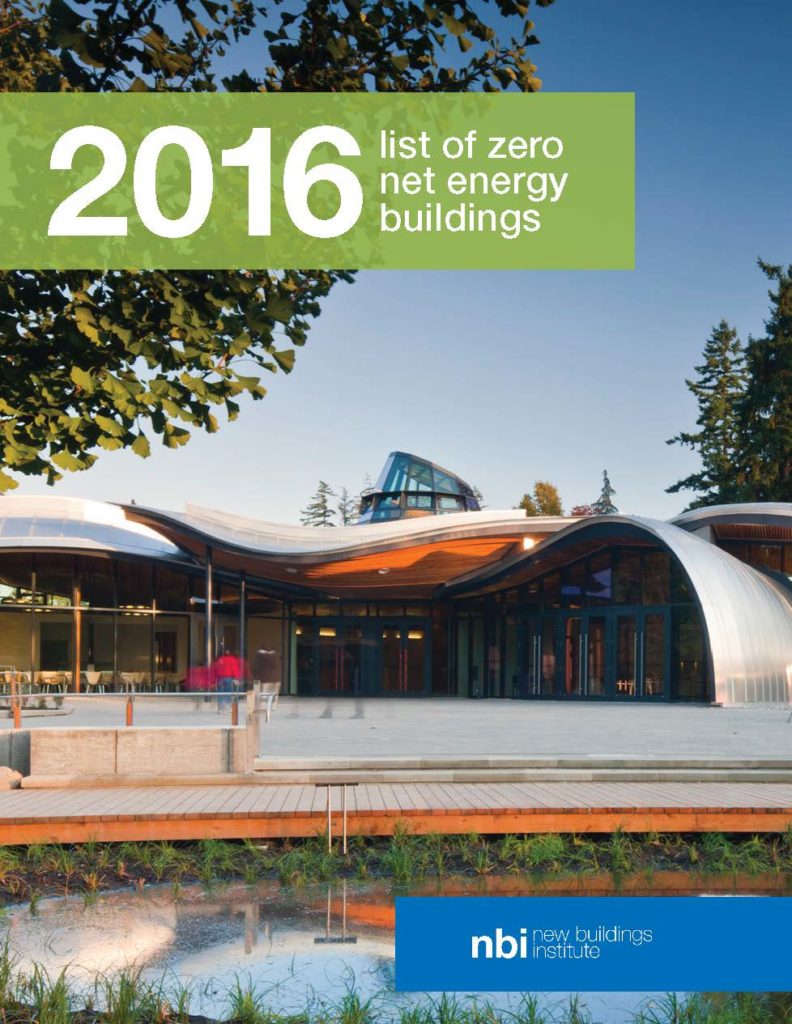
List of Zero Net Energy Buildings
Report / October 13, 2016
NBI is home to the most extensive data set on zero energy, low-carbon buildings in the world. We regularly publish Getting to Zero Buildings Lists that show growth and market trends for zero. The lists for 2015, 2016 and 2018…
Zero Net Energy Buildings and the Grid
Paper / April 5, 2016 / Zero Net Energy (ZNE)
With exponential growth predicted for U.S. solar installations, substantial distributed energy supply will be available to buildings and communities across the country. When coupled with a highly efficient, intelligent buildings, these resources represent a tremendous asset, but also a complicated…
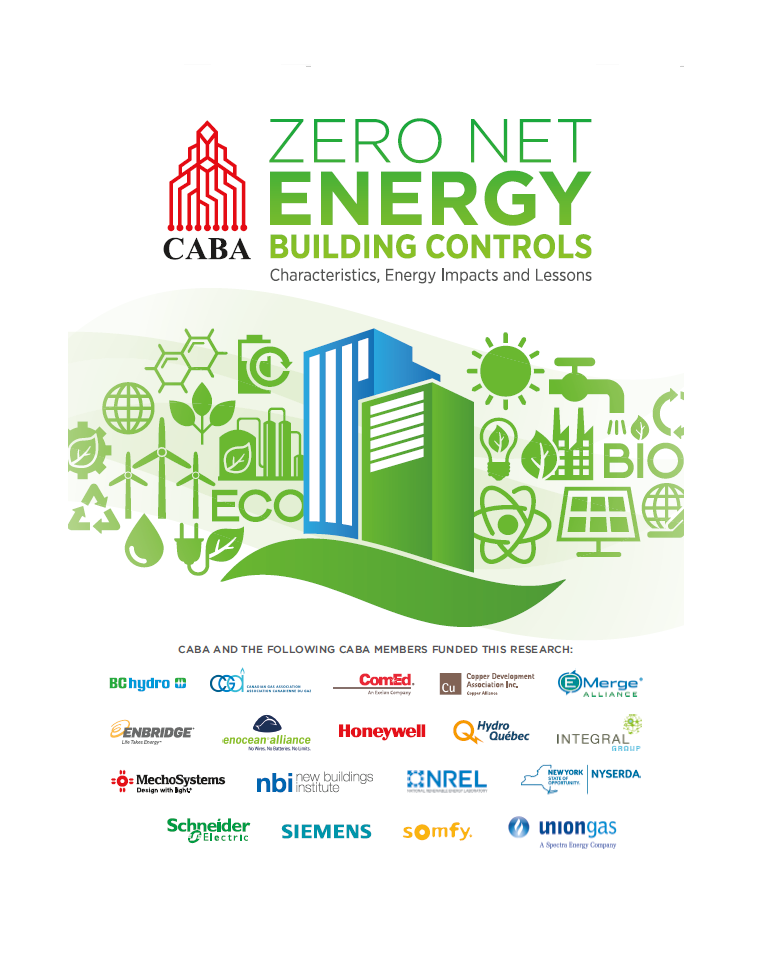
Zero Net Energy Building Controls: Characteristics, Energy Impacts and Lessons Learned Research Report
Report / December 19, 2015 / Controls
This commercial building research project was conducted by New Buildings Institute and led by the Continental Automated of Buildings Association (CABA). The objective was to characterize monitoring and control systems in Zero Net Energy (ZNE) buildings focused on three key…
Proposed Multifamily Building Section for the 2018 IECC
Document / October 16, 2015
NBI presented the first public “straw-man” of a proposed section for multifamily buildings in the 2018 International Energy Conservation Code (IECC) to the Department of Energy's Denver Energy Codes Stakeholder Meeting on October 13, 2015.
Washington State Energy Code Roadmap
Report / September 11, 2015
The purpose of this roadmap is to provide context for the policy and code performance goals for new buildings in Washington law and identify the mechanisms and cycles by which code provisions can evolve to meet these goals. These code…
Progress Report 2013-2014
Report / August 13, 2015
This Progress Report begins with a message from our CEO and Board President and contains key highlights from our programs, reports and news.
Getting to Outcome-Based Building Performance Event Report
Report / May 6, 2015
This report summarizes the work undertaken by a group of building industry thought leaders who gathered for a Performance Outcome Summit in August 2014 in Seattle, Washington. During a day and a half workshop, the group examined the opportunities, barriers…
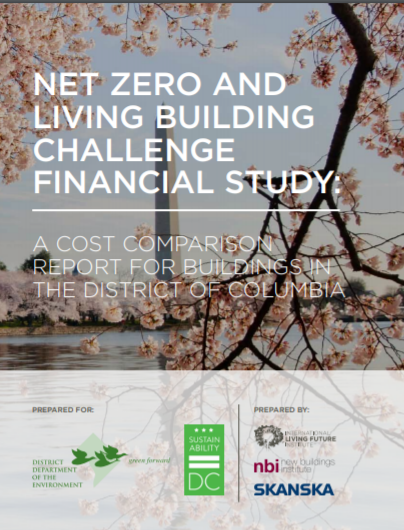
Net Zero and Living Building Challenge Financial Study: A Cost Comparison Report for Buildings
Report / April 16, 2014
The Net Zero and Living Building Challenge Financial Study investigates the anticipated cost differential between a set of three reference buildings designed to the LEED Platinum standard and those same three buildings conceptually designed for deep energy efficiency, net zero…
Essential 7: Commercial Energy Code Voting Guidance for the 2015 IECC-Comm
Document / October 1, 2013
New Buildings Institute, Northwest Energy Codes Group, Institute for Market Transformation and Southwest Energy Efficiency Project identified seven key issues to ensure that the 2015 IECC improves energy efficiency, is easier to apply, and makes compliance and enforcement more straightforward.…
High Performance Buildings Measured Performance and Key Performance Indicators
Report / April 24, 2013
This Final Research Summary Report summarizes the findings for the High Performance Buildings Measured Performance and Key Performance Indicators project within the Evidence-based Design and Operation research program.
Title 24 Final FDD Language and Explanation
Document / April 24, 2013
The language included in the California Title 24-2013 Energy Standards for Non-Residential Buildings requiring certain FDD features in all new rooftop unit heating and cooling equipment of 5-ton capacity or greater starting in 2014.
Evidence-Based Design and Operations PIER Program: Improving the Real World Performance of Commercial Buildings
Report / April 23, 2013
This Final Project Report presents the results of the Evidence-based Design and Operations Research Program led by New Buildings Institute from 2008-2013. The program included four technical projects for commercial buildings. This work included the development of feedback tools for…
Enhanced Skylight Modeling and Validation
Report / April 23, 2013
This report details tasks, findings, and recommendations undertaken for the Enhanced Skylight Modeling and Validation project. The scope involved developing and validating computer simulation alternatives to physical measurements for producing optical daylighting system photometry.
Plug Loads
Report / March 24, 2013
Plug loads are among the biggest energy end uses in commercial office buildings. This is in part because plug loads are growing with greater information technology power demand and also because design approaches, codes and efficiency programs typically address other…
PIER Research Results
Report / March 19, 2013
Since 2000 NBI has been a part of major energy efficiency research on behalf of the California Energy Commission through the Public Interest Energy Research (PIER) endeavor. NBI’s latest PIER research program, Evidence-based Design and Operations, began in 2008 and…
Utility Programs in a World of Rapid, Code-Induced Advancements in Energy Baselines
Paper / September 7, 2012
In recent years, model energy codes – which traditionally require the implementation of specific measures and strategies at the time of new commercial and residential construction – have set the stage for large increases in energy savings as states and…
Key Performance Indicators – Field Metering Study and Energy Performance Feedback
Report / July 23, 2012
This report describes an investigation by NBI of metered key performance indicators (KPI) for commercial building energy use.
White Paper on Establishing a Pathway to Outcome-Based Code Policy
Paper / May 16, 2012
For several years, NBI has been engaged in wide‐ranging conversations about code stringency increases and the degree to which current code strategies can continue to achieve aggressive efficiency goals that have been targeted. We have come to recognize that current…
A Search for Deep Energy Savings
Report / August 23, 2011
A report from NEEA's BetterBricks program and New Buildings Institute investigates* 11 energy retrofits in existing commercial buildings that, on average, resulted in energy use 50% less than the national average – many with an energy use intensity (EUI) below…
Sensitivity Analysis: Comparing the Impact of Design, Operation, and Tenant Behavior on Building Energy Performance
Report / July 27, 2011
This study compares the magnitude of energy impact that various design features, operations and tenant behaviors have on total building energy use. The findings of this study can help the building community begin to align their priorities with those building…
Green Building Performance Evaluation: Measured Results from LEED-New Construction Buildings
Report / July 7, 2011
Is LEED delivering actual energy savings? This study addresses that question with a post-occupancy assessment of 121 LEED buildings across the country. Input to the study consisted of energy bills and brief descriptions of actual building use from owners, plus…
How Accurate is Energy Modeling in the Market?
Paper / June 21, 2011
This paper presents a study of whole building energy use of various completed LEED buildings throughout the nation. The paper focuses on the relationships between predicted and actual energy performance of 90 completed LEED certified buildings. The results of the…
Outcome-Based Energy Codes for Existing Buildings, Seattle Model Energy Code Project
Report / May 16, 2011
The Preservation Green Lab (PGL), the City of Seattle, and New Buildings Institute (NBI) are collaborating on a new energy code framework for existing and historic buildings that will pair accountability for actual performance outcomes with flexibility in how building…
Using Measured Whole-Building Performance for Green Building Program Evaluation
Paper / December 28, 2010
Green building program energy efficiency strategies often use integrated design, precluding the measurement of results simply from deemed savings of specific measures. This paper describes the use of whole-building measured energy use, by month and fuel, to evaluate the achievements…
A Tool for Efficient First-Views of Commercial Building Performance Results
Paper / August 19, 2010
This paper describes a new method of benchmarking monthly whole building energy. The resulting “first view” can identify the general nature of major building inefficiencies, thus directing further investigation of specific problems. The research, funded by a grant from EPA,…
Code Calibration: Understanding What Energy Codes Can Really Achieve
Paper / July 28, 2010
This paper observes that a key problem with current energy code practice is the difficulty in determining what level of performance the codes are delivering. Current energy code practice is based on estimated energy use of a theoretical sample of…
Energy Performance of LEED for New Construction Buildings
Report / February 17, 2010
NBI has completed the broadest study to-date of measured energy performance of LEED buildings called “Energy Performance of LEED for New Construction Buildings.” Aimed at better quantifying the actual energy performance levels of green building, the study gathered whole building…
Assessment of Market-Ready Evaporative Technologies for HVAC Applications
Report / January 28, 2010
NBI completed a report on the range of evaporative, evaporative hybrid and evaporative condensing technologies for HVAC applications on behalf of Southern California Edison including: technologies, manufacturers, market applications and adoption factors surrounding evaporative approaches to cooling.
California Outdoor Lighting Baseline Assessment
Report / January 21, 2010
This is the first major study to provide real data about commercial building outdoor lighting in the State of California. The report identifies statewide outdoor lighting design practices; estimates energy demand and consumption; and provides a framework for outdoor lighting…
Summary and Recommendations of the Getting to 50 Summit
Report / January 21, 2010
In March 2007, New Buildings Institute (NBI) hosted and facilitated the Getting to 50 Summit. This meeting of 60 experts was initiated to develop relationships and strategies which will significantly and rapidly reduce energy use in new and renovated commercial…
Windows and Offices: A Study of Office Worker Performance and the Indoor Environment
Report / October 21, 2003
This study reports on a statistical investigation into the influences indoor physical environment has on office worker performance, especially daylight and view, and secondarily ventilation and thermal comfort.
Windows and Classrooms: A Study of Student Performance and the Indoor Environment
Report / October 21, 2003
This study investigates whether daylight and other aspects of the indoor environment in elementary school student classrooms have an effect on student learning, as measured by their improvement on standardized math and reading tests over an academic year.
Daylight and Retail Sales
Report / October 21, 2003
This study presents evidence that a chain retailer is experiencing higher sales in daylit stores than in similar non-daylit stores.
Events
There are no events for Outcome-Based Performance. Please see our other events below.
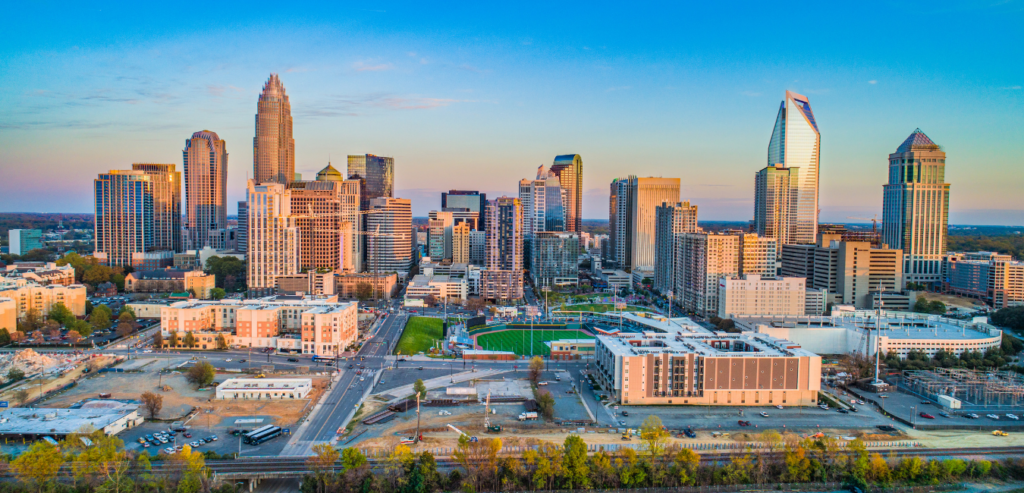
2024 Getting to Zero Forum
Event / May 21, 2024 - May 23, 2024
The Getting to Zero Forum is the premier event dedicated to building decarbonization. With a growing number of climate emergencies across the United States and around the world, there is no more important time than now for the Getting to…

Combi Heat Pump Webinar
Webinar / May 22, 2024 @ 10:00 am - 11:00 am PDT
This webinar will delve into combination space and water heating systems, also known as combi systems. While these systems seem promising, they present a level of complexity that raises questions about their practicality. The current market boasts standalone heat pump…
NewsView All
NIBS, NBI Issue Guidance to Help Jurisdictions Achieve Energy Goals
News / November 1, 2017
Outcome-Based Path for Codes Focuses on Results, Looks at Building’s Actual Performance A number of cities and states across the United States have begun to recognize that the current code-based mechanisms in place do not provide the means to help...
Industry experts plan for future focused on commercial building performance outcomes, increased attention to operations
News / May 6, 2015
Determining a building’s energy efficiency based solely on using predictive energy models and specifying certain design and construction attributes may be a thing of the past by the time the next generation of architects and engineers join the workforce. Communities...
Blog
NBI and NIBS Convene a Stellar Cast for August Summit with Compelling Outcomes
Post / September 12, 2014
NBI was thrilled to partner with National Institute of Building Sciences (NIBS) to host the Getting to Outcome-Based Performance Summit in Seattle. Together with a handpicked group of leading thinkers and practitioners in high performance building design, construction and operations, we...
Case StudiesView All
There are no case studies for Outcome-Based Performance. Please see our other case studies below.
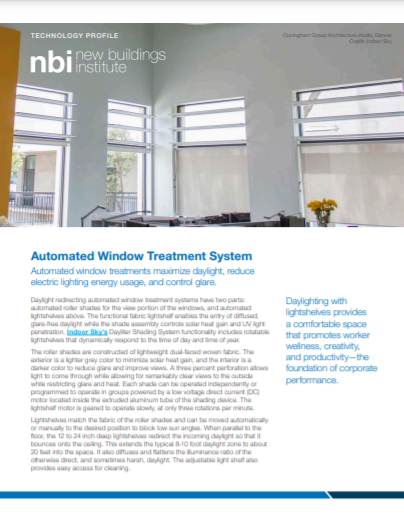
Automated Window Treatment Case Study
Case Study / June 1, 2021
Several manufacturers offer innovative window treatment solutions that allow daylight into spaces while controlling for glare and allowing views to the outdoors. In this case study, we focus on Indoor Sky’s Daylighter Shading System. The system has two parts: automated…
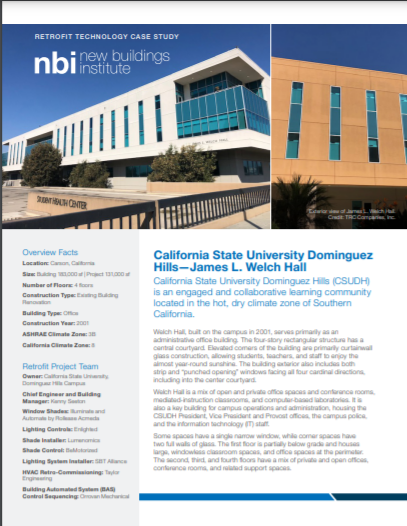
California State University Dominguez Hills—James L. Welch Hall
Case Study / June 1, 2021
The Welch Hall building on the CSUDH campus partnered with the project team to retrofit their existing Enlighted lighting system and manual shades to the INTER package – which included LED lighting with Luminaire-level lighting control (LLLC), solar-powered automated shades,…
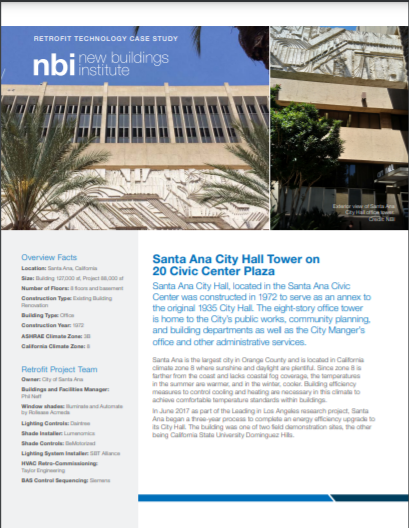
Santa Ana City Hall Tower on 20 Civic Center Plaza
Case Study / June 1, 2021
The City Hall building in Santa Ana sought to improve their indoor environment and save on energy costs with automated shades, upgraded lighting fixtures and networked lighting controls. The project updated the existing T8 lamps to LEDs and controlled the…
Ultra-Low Energy Campus Case Study: King Open/Cambridge Street Upper Schools and Community Complex Case Study
Case Study / July 20, 2020
In 2015 the Cambridge city council voted to adopt a Net Zero Action Plan, requiring all city buildings to target net zero energy design by 2020. When the City issued the request for proposals for the new King Open/Cambridge Street…
Emerging Zero Net Energy School Retrofit Case Study: Los Osos Middle School
Case Study / January 24, 2018
The mild climate in coastal cities such as Los Osos makes ZNE performance a realistic target with minimal needs for heating and cooling. It should however be noted that in such mild climates payback on upgrades to heating systems can…
Emerging Zero Net Energy School Retrofit Case Study: Newcastle Elementary School
Case Study / January 24, 2018
With funding from California’s Prop 39, the Newcastle Elementary School District (ESD) issued a request for proposal to develop an Energy Expenditure Plan for their district. With a long list of deferred maintenance issues and budget challenges, Newcastle ESD was…
Emerging Zero Net Energy School Retrofit Case Study: Garden Grove School District
Case Study / January 24, 2018
Garden Grove Unified School District (GGUSD) is a large, low-income school district that has recently become a regional leader in Zero Net Energy. Among California’s 140 school districts with greater than 65% for Free & Reduced Price Meals, GGUSD was…
Radiant Cooling and Heating Systems
Case Study / September 13, 2017 / HVAC
Several buildings with radiant heating and cooling systems were studied under a California Energy Commission EPIC research project in 2016-2017 and those case studies are available here. While forced-air distribution systems remain the predominant approach to heating and cooling in…
Verified ZNE Building Case Study: North Face & VF Outdoors
Case Study / March 8, 2017
The North Face corporate facility is part of the VF Outdoor Campus in Alameda, California. The VF Outdoors Headquarters occupies 14 acres of the Harbor Business Park and includes a 160,000-square-foot, four-building development completed in 2012. A fifth building is…
Emerging ZNE Building Case Study: Environmental Innovation Center
Case Study / March 8, 2017
Completed in 2014, the Environmental Innovation Center (EIC) in San José, CA, is a local government-owned education and environmental resources center that is targeting zero net energy (ZNE) performance. The project contains a 10,000-square-foot new building and a retrofit of…
Emerging ZNE Building Case Study: California State Lottery District Office in Santa Fe Springs
Case Study / March 8, 2017
The California State Lottery District Office in Santa Fe Springs is a retrofit of an existing 12,840-square-foot warehouse and is one of the first state-owned and operated buildings to target zero net energy (ZNE). The Lottery partnered with LPAS Architecture…
Verified ZNE Building Case Study: Bagatelos Architectural Glass Systems Manufacturing Facility
Case Study / March 8, 2017
The Bagatelos Architectural Glass Systems (BAGS) manufacturing facility is a retrofit of a 1969 concrete warehouse that was renovated in 2008 to be a zero net energy (ZNE) building. The 63,000-square-foot Bagatelos Architectural Glass Systems manufacturing facility produces custom glass…
Verified ZNE Building Case Study: 435 Indio Way
Case Study / March 8, 2017
435 Indio Way in Sunnyvale, California, was built in 1973 as a research and development laboratory and office for Hewlett Packard. Like many buildings in the Silicon Valley, it is a simple one-story, tilt-up that since 2006 had been left…
Ultra-Low Energy School Case Study: Jeffrey Trail Middle School
Case Study / December 13, 2016
The Jeffrey Trail Middle School is a new school in the Irvine Unified School District (IUSD). The school was designed and constructed to meet the Collaborative for High Performance Schools (CHPS) performance standards for exemplary energy and water conservation. With…
Ultra-Low Energy School Case Study: Georgina Blach Intermediate School
Case Study / December 13, 2016
The Georgina Blach Intermediate School, part of the Los Altos School District, Iocated in Los Altos, California, serves 450 students in seventh and eighth grades. Facilities at the school were unimproved since their construction in 1958, 1962-63 and 1978 and…
Emerging ZNE School Case Study: George V. LeyVa Middle School Administration Building
Case Study / December 13, 2016
The George V. LeyVa Middle School Administration Building was designed to be one of the first zero net energy (ZNE) public school buildings in California as well as the first zero net emissions public school building in California. This leading…
Verified ZNE Case Study: West Berkeley Public Library
Case Study / December 13, 2016
The West Berkeley Public Library is the first verified zero net energy (ZNE) public library in California. Completed in late 2013, the 9,400-square-foot library produces as much or more energy than it consumes on an annual basis. To reach its…
Ultra-Low Energy School Case Study: San Francisco City College Multi-Use Building
Case Study / December 13, 2016
The San Francisco City College Multi-Use Building is a pioneering project for large, low-energy facilities. At 102,000 square feet, the building is one of the largest in the United States to rely nearly entirely on natural ventilation to meet fresh…
Verified ZNE Multifamily Case Study: zHome Multifamily Complex
Case Study / October 10, 2016
The zHome multifamily complex was the first zero net energy project of its kind in the United States. This complex is made up of 10 units and a shared community area. The design approach of the project centered on energy…
Verified ZNE Portfolio Case Study: Gundersen Health System
Case Study / October 10, 2016
Gundersen Health System is the largest portfolio of buildings striving to reach zero net energy performance on a district wide scale in North America. The portfolio is made up of 45 new and existing buildings and spanning more than 2.5…
Savings Verification for Performance Contracting
Case Study / December 23, 2015
Washington’s Department of General Administration supervised an energy system retrofit of Spokane’s Westlake State Hospital and then was responsible for verifying the energy savings resulting from the improvements. However, when the hospital’s energy management system experienced a partial loss of…
The Runaway Building
Case Study / December 23, 2015
EZ Sim showed its versatility and its accuracy when analyzing a building with run away winter energy bills. While the building was initially modeled using a traditional engineering method, EZ Sim provided a quicker alternative to identify the nature of…
EZ SIM – Shows Bonus Energy Savings for County Office Building
Case Study / December 23, 2015
When a county building’s facility manager wanted to know if it was time to upgrade the building’s heat pumps, EZ Sim’s detective work helped to uncover more savings in more places than she bargained.
New England Regional Council of Carpenters
Case Study / December 23, 2015
The New England Regional Council of Carpenters (NERCC) represents 22,000 carpenters, pile drivers, shop and mill men, and floorcoverers working in the New England states.
Gibney Family Vision Center
Case Study / December 23, 2015
The Vermont Association for the Blind and Visually Impaired (VABVI), a non-profit organization founded in 1926, is the only private rehabilitation agency to offer free training, services and support to visually impaired Vermonters of all ages. VABVI offices are located…
Fidelity Bank
Case Study / December 23, 2015
Fidelity Bank is one of the oldest and continually growing independent, local community banks in Central Massachusetts. In January 2007, the bank opened its new Corporate Center and Branch in Leominster, Massachusetts. The four-story building includes office space as well…
Duxbury Bay Maritime School
Case Study / December 23, 2015
Serving more than 1,800 students annually, the not-for-profit Duxbury Bay Maritime School aims to connect the community through educational and recreational programs with its primary resource, Duxbury Bay.
Child and Family of Newport County
Case Study / December 23, 2015
Child and Family of Newport County (CF) is a nonprofit organization dedicated to strengthening families and communities through services such as preschool childcare, counseling, home care for the elderly and disabled, substance abuse education, home-based child welfare, transitional housing for…
Abraham Lincoln Elementary School
Case Study / December 23, 2015
In September 2010, the Abraham Lincoln Elementary School opened its new green building, ready to accommodate 600 students. This new building includes masonry and steel construction, a 3,300 square foot state-of-the-art library and media center, a 5,700 square foot gymnasium,…
New Construction Project Directory & Case Studies
Case Study / December 23, 2015
Information about New Construction projects that have utilized Core Performance are available here and, when available, include links to case studies or project profiles.
Emerging ZNE K-12 School: Turkey Foot Middle School
Case Study / December 19, 2015
The Kenton County School District believes “schools should use less energy, demonstrate sound environmental practices and serve as a fundamental tool for learning.” Since the District had experience with a formal energy management program that saved over $2 million since…
Ultra-Low Energy Building: The Ramona
Case Study / December 19, 2015
The Ramona is a mixed-use development in the urban Pearl District of Portland, Oregon. The building hosts 138 units of affordable housing and two educational facilities. Portland Public Schools rents 13,000 SF for programs for children ages 3 to 6.…
Verified ZNE Retail Bank Branch: TD Bank
Case Study / December 19, 2015
TD Bank has been an environmental leader since 1990. As one of the ten largest banks in the United States, they chose to move beyond LEED certification to pilot a Zero Net Energy design for a retail bank branch in…
Emerging ZNE K-12 School: Dr. David Suzuki Public School
Case Study / December 19, 2015
The Dr. David Suzuki Public School combines readily available and demonstration technologies to create a school building that serves as a living laboratory for 550 students in Windsor, Ontario. The two-story kindergarten through 8th grade school includes classrooms, a gymnasium,…
Emerging ZNE Building: Rice Fergus Miller Office and Studio
Case Study / December 19, 2015
Rice Fergus Miller breathed new life into an abandoned 1948 Sears Automotive Center and positioned their new office solidly on the path to net zero. This urban infill transformation project took a dilapidated structure that had been abandoned for 23…
Verified ZNE School: Putney Field House
Case Study / December 19, 2015
The Putney Field House is located on a 461-acre parcel, with areas dedicated to forestry, education and agriculture. The site includes indigenous plantings and a production garden. The state-of-the art field house and wellness center was built to provide winter…
Verified ZNE Building: Leon County Cooperative Extension Office Building
Case Study / December 19, 2015
The mission of the Leon County Cooperative Extension is to educate the community about research performed at the University of Florida through interactive opportunities and demonstration sites. A recent retrofit of their 13,000 SF office was the perfect opportunity to…
Verified ZNE District: Anna Maria Historic Green Village
Case Study / December 19, 2015
The Anna Maria Historic Green Village is an unusual combination of historic restoration and modern technology. Owners Mike and Lizzie Thrasher have worked diligently to preserve four 100-year old buildings and merge history with state-of-the-art green technology, all while bringing…
Emerging ZNE Museum: Exploratorium
Case Study / December 19, 2015
When the Exploratorium outgrew its old location at the Palace of Fine Arts, the City of San Francisco offered to provide Piers 15 and 17 on its historic waterfront as a larger relocation option for the science museum. After structurally…
Verified ZNE Small Office Retrofit: Bacon Street Offices
Case Study / December 19, 2015
The Bacon Street Office project is a 4,500 SF retrofit of a single-story, 1950’s-era auto repair shop into a high performance office for the firm ARCHITECTS hannah gabriel wells. Through creative design strategies, renewable energy generation and with support from…
Verified ZNE Training Center: Zero Net Energy Center
Case Study / December 19, 2015
When it came time to upgrade their training facility, the IBEW Local 595 and NECA chapters targeted net zero energy. They wanted to demonstrate that this goal was achievable and train their electrical contractors on the latest, cutting-edge energy efficiency…
Verified ZNE Office: David and Lucile Packard Foundation
Case Study / December 19, 2015
When the Packard Foundation started thinking about building a new headquarters, they wanted to make sure the final product reflected the organization’s values. These include conserving the Earth’s natural resources over the long-term, providing a comfortable and healthy space that…
Ultra-Low Energy High Rise Office: The San Francisco Public Utilities Commission (SFPUC) Headquarters
Case Study / December 19, 2015 / Existing Buildings
The San Francisco Public Utilities Commission (SFPUC) headquarters is an ultralow-energy, Class A office building that pushes the norm in sustainable design. Located in downtown San Francisco, the 13-story building houses more than 900 employees who were previously located in…
Ultra-Low Energy Multifamily Residence: La Valentina North Townhomes
Case Study / December 19, 2015 / Existing Buildings
The La Valentine North Townhome project is the result of a partnership between SMUD and the owner/developer of the project, Domus Development LLC. The 18-unit affordable multifamily development is a research and demonstration project in SMUD’s Townhouse Home of the…
Verified ZNE K-12 School: Redding School for the Arts
Case Study / December 19, 2015 / Existing Buildings
Redding School for the Arts in Northern California connects education and arts for K-8 students in a community of 90,000 people. The school was originally created in August 1999 in response to the rapid decline of arts programs in local…
Verified ZNE Small Office Retrofit: DPR Construction
Case Study / December 19, 2015 / Existing Buildings
Acting as owner, designer and contractor, DPR rehabbed a near-obsolete, 1984 building into a vibrant, zero-net energy multi-tenant office. DPR’s new 24,000 SF tenant improvement includes an open office space along with 11 conference rooms, a large gathering area and…
StopWaste
Case Study / June 6, 2012
In March 2007, 31 staff at StopWaste.Org moved into a renovated building in downtown Oakland, California. Their goal was to transform a dilapidated, 14,000 SF, two-story structure into an attractive and environmentally responsible building. Built in 1926, the building is…
Case Studies of Applications for FirstView Software
Case Study / May 21, 2012
Several organizations and companies have utilized the FirstView™ software to analyze building energy performance. Some have relied on FirstView software for diagnostics to lead them to potential areas for improvement, while others have used FirstView software as a way to…
FirstView and USGBC Building Performance
Case Study / May 18, 2012
NBI's FirstView™ software and services have been used on over 200 LEED buildings involved in the U.S. Green Building Council’s Building Performance Partnership (BPP). BPP is a voluntary program designed to improve the performance of green buildings by providing a…
Joseph Vance Building
Case Study / April 27, 2012
Since its acquisition, significant investments have been made to renovate this building in Seattle to improve energy efficiency and environmental performance, as well as tenant experience. Occupancy increased from 68% to 96% and has seen increased rents, tenant retention and…
Lovejoy Building Case Study
Case Study / April 27, 2012
In Portland, OR a retrofit of the existing load-bearing brick structure required a major seismic upgrade in this building. The architects used this as an opportunity for an integrated response to advanced structural upgrades, enhanced user thermal comfort and improved…
Johnson Braund Design Group Case Study
Case Study / April 27, 2012
Johnson Braund Design Group (JBDG) in Seattle was able to dramatically improve their building’s energy performance, reduce operating costs and provide a test ground for energy-efficient design strategies to influence its clients. The JBDG Building now uses 69% less energy…
Christman Building Case Study
Case Study / April 27, 2012
The Christman in Lansing, MI is one of the few Triple LEED Platinum buildings designated by the USGBC LEED Program. The building is located in a climate zone comparable to Montana, northeast Washington and eastern Idaho, and its age and…
Aventine Case Study
Case Study / April 27, 2012
The Aventine in LaJolla, CA is a certified LEED Existing Building Platinum and has an Energy Star rating of 100, the highest possible, and uses just 23 kBtus/sf, 75% less than the national average for offices. Retrofits addressed high-energy loads…
1525 Wilson Boulevard
Case Study / April 27, 2012
This all-electric building in Rossyln, VA used a combination of energy efficiency strategies, including replacing HVAC and lighting systems and providing tenant education. Energy use was reduced by 35% in just one year, resulting in savings over $250,000 on energy…
Mercy Corps Headquarters
Case Study / April 27, 2012
This building in Portland, OR is 50% historic renovation and 50% new construction. The information in this profile addresses both the renovated and the new parts of the building. Pursuing energy efficiency supports their mission of sustainability, and lower operating…
Home On The Range
Case Study / April 27, 2012
This Project Profile builds on a case study prepared by USGBC, including data on energy performance for one year, and provides updated owner feedback and energy use data. The actual energy use of the building in Billings, MT, is 46…
Beardmore Building
Case Study / April 27, 2012
The Beardmore in Priest River, Idaho has the distinction of being one of the few buildings in the country that is both LEED Gold certified and on the National Register of Historic Places. The project demonstrates a very successful renovation…
200 Market Building
Case Study / April 27, 2012
The 200 Market building in Portland, OR, has made continuous energy retrofits and system improvements. These efforts have moved the building from an ENERGY STAR score of 79 in 2006 to a score of 98 (out of 100) in 2010,…
Alliance Center
Case Study / April 27, 2012
The Alliance for Sustainable Colorado launched a project titled “Modeling a Net Zero Future: Energy Efficiency in Existing Buildings” to explore options that will enable it to approach a zero-net energy goal. Several documents developed for the project are referenced…
Verified Zero Energy Building: IDeAs Z2 Design Facility
Case Study / April 26, 2012
IDeAs’ new headquarters in San Jose, CA was designed to meet 100% of its net energy requirements using renewable energy from photovoltaics.
A Zero Energy-Capable Building: Jane D’Aza Convent, House of Formation
Case Study / April 25, 2012
This series of smaller buildings in San Rafael, CA reflects a contemporary vision that includes a strong commitment to environmental responsibility.
Ultra-Low Energy Building: Doyle Conservation Center
Case Study / April 25, 2012
This training facility showcases the organization’s conservation activities. The LEED Gold rating reflects the mission of the Trustees of Reservations, which is “To preserve for public use and enjoyment, properties of exceptional scenic, historic, and ecological value in Massachusetts.”
Ultra-Low Energy School: Plano Elementary School
Case Study / April 25, 2012
Plano Elementary School serves 435 students in Warren County, Kentucky. The building includes 32 classrooms, 14 offices, six resource centers, media center, gym, server room, and cafeteria with kitchen. There are 20 public schools in this district and five of…
Ultra-Low Energy Building: Gilman Ordway Building at the Woods Hole Research Center
Case Study / April 25, 2012
In Falmouth, MA a 19th-century summer home is respectfully adapted with the addition of a contemporary office, laboratory, and common spaces. The integration of passive-solar and energy-conservation strategies, optimal performance, and onsite renewable power generation make this building 83% more…
A Zero Energy-Capable Building: Kirsch Center for Environmental Studies
Case Study / April 25, 2012
For this two-story building in Cupertino, CA the design process moved through six steps to responsibly approach carbon neutral operation and roughly track increasing cost effectiveness.
Verified Zero Energy Building: Omega Center for Sustainable Living
Case Study / April 25, 2012
Achieving net-zero energy required a design that eliminated waste and maximized the use of renewable energy resources. This building in Rhinebeck, NY is purposely compact, organized to harvest daylight, solar energy, and cooling breezes to reduce energy needs
A Zero Energy-Capable Building: Wampanoag Tribal Headquarters
Case Study / April 25, 2012
This building serves as an administrative, educational, and social center for the Wampanoag tribe, which has inhabited Martha’s Vineyard for hundreds of years. The design approach embodies the traditional Native American belief system of interdependence and respect for nature.
A Case For Deep Savings: 11 Case studies of Deep Energy Retrofits
Case Study / August 23, 2011
For NEEA’s BetterBricks program, New Buildings Institute investigated* 11 examples of energy retrofits in existing commercial buildings that, on average, use 50% less energy than the national average – most with an energy use intensity (EUI) of less than 40…
Measured Performance Case Study: Classroom & Office Building, UC Merced
Case Study / January 26, 2010
The Classroom and Office Building (COB) examined in this case study is one of five buildings in the initial phase of development at UC Merced. This case study examines the actual post-occupancy performance of COB in relation to design elements…
Measured Performance Case Study: Science & Engineering Building 1, UC Merced
Case Study / January 26, 2010
Science & Engineering (S&E) Building I is one of five buildings in the initial phase of development at UC Merced. This case study examines the actual post-occupancy energy performance of S&E in relation to design elements and objectives.
Tools & Guides
There are no tools and guides for Outcome-Based Performance. Please see our other tools and guides below.
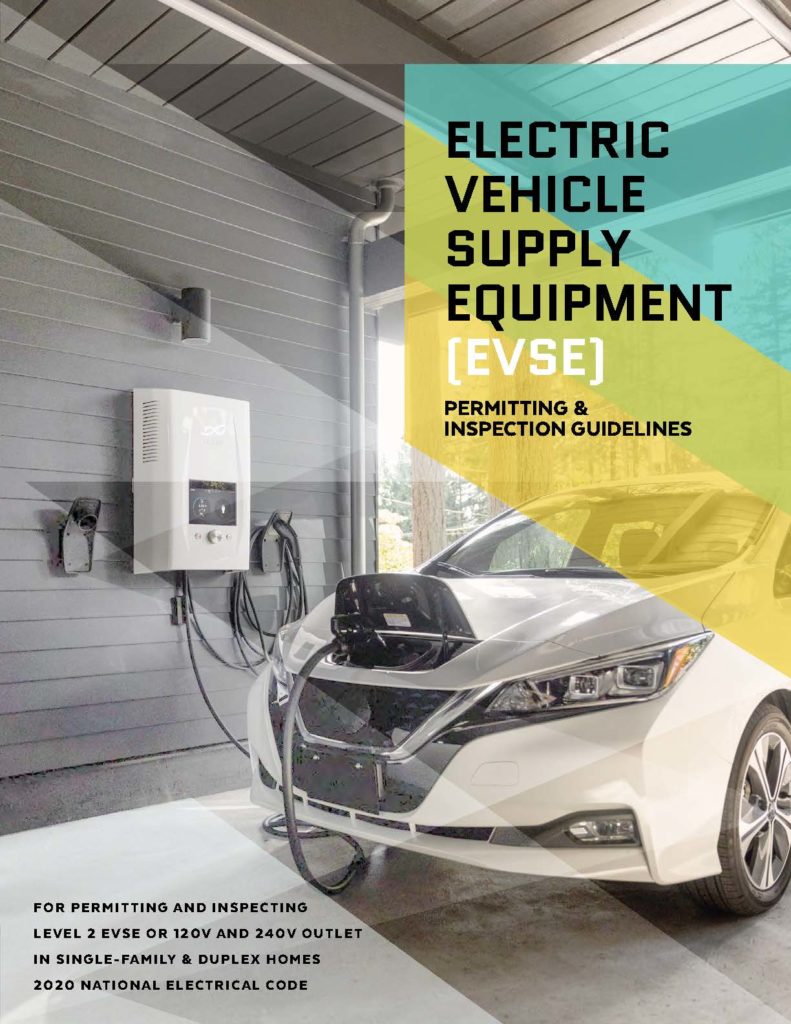
Electric Vehicle Supply Equipment, Energy Storage and Solar Permitting and Inspection Guidelines
Guideline / March 26, 2024
In many parts of the United States, navigating building permits required for distributed energy resources such as solar, storage, and electric vehicles (EVs) can be a daunting process. Under a three-year project funded by the Department of Energy, NBI has led…
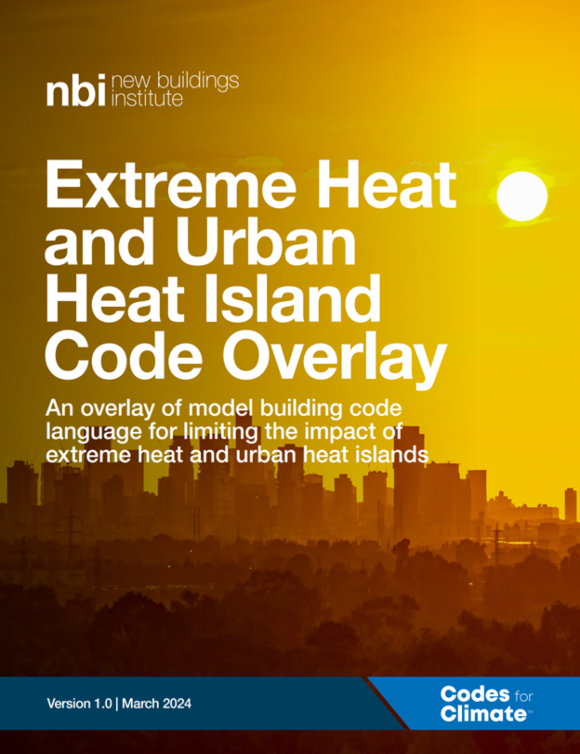
Extreme Heat and Urban Heat Island Code Overlay
Guideline / March 20, 2024
The Extreme Heat and Urban Heat Island Code Overlay provides code language for jurisdictions interested in acting against extreme heat and mitigating the urban heat island (UHI) effect. The Code Overlay strengthens and expands on cool surface requirements in model…

Embodied Carbon Building Code
Guideline / August 31, 2023
The Embodied Carbon Building Code overlay introduces code solutions incorporating prescriptive embodied carbon International Building Code (IBC) amendments for nearly 40 products, encompassing widely used and high carbon-emitting building materials. The overlay was created for policymakers seeking code language to…
Interactive Map of Carbon Neutral School Districts
Online Tool / June 1, 2023
This interactive map includes districts that have addressed healthy, efficient, resilient schools by adopting formal goals to tackle carbon emissions. These goals may be written into policies, resolutions, plans, design standards, or other formal mechanisms. Carbon emissions reductions encompass a…
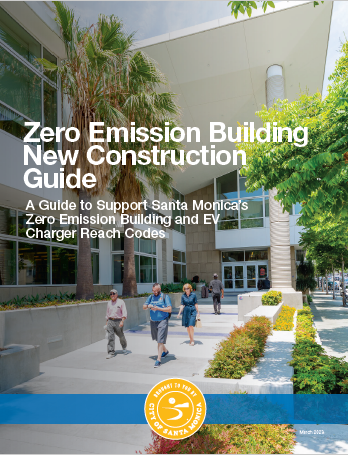
Zero Emission Building New Construction Guide
Guideline / May 4, 2023
Zero Emission Building New Construction Guide: This guide supports compliance with the Santa Monica ZEB Code and EV Charger Reach Code by providing guidance for meeting all of their requirements, including All-Electric Design, EV charging spaces, and tips to maximize…
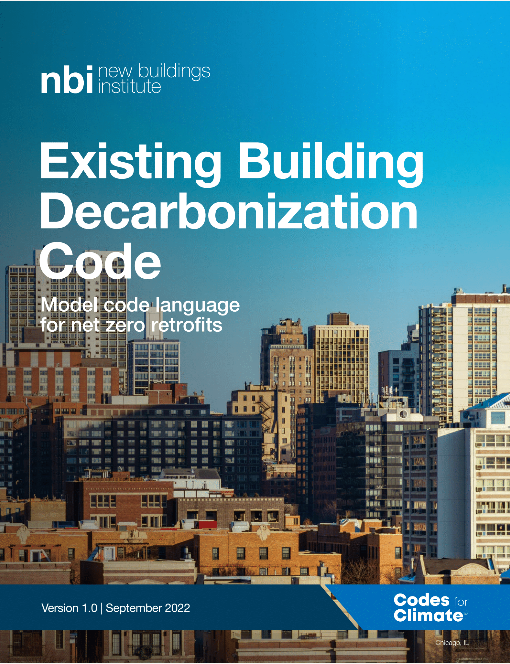
Existing Building Decarbonization Code
Guideline / September 19, 2022
The Existing Building Decarbonization Code is a new way for jurisdictions to reduce carbon emissions and meet Climate Action Plan and public health and equity goals. The need to address existing building stock is great, with 5.9 million existing commercial…
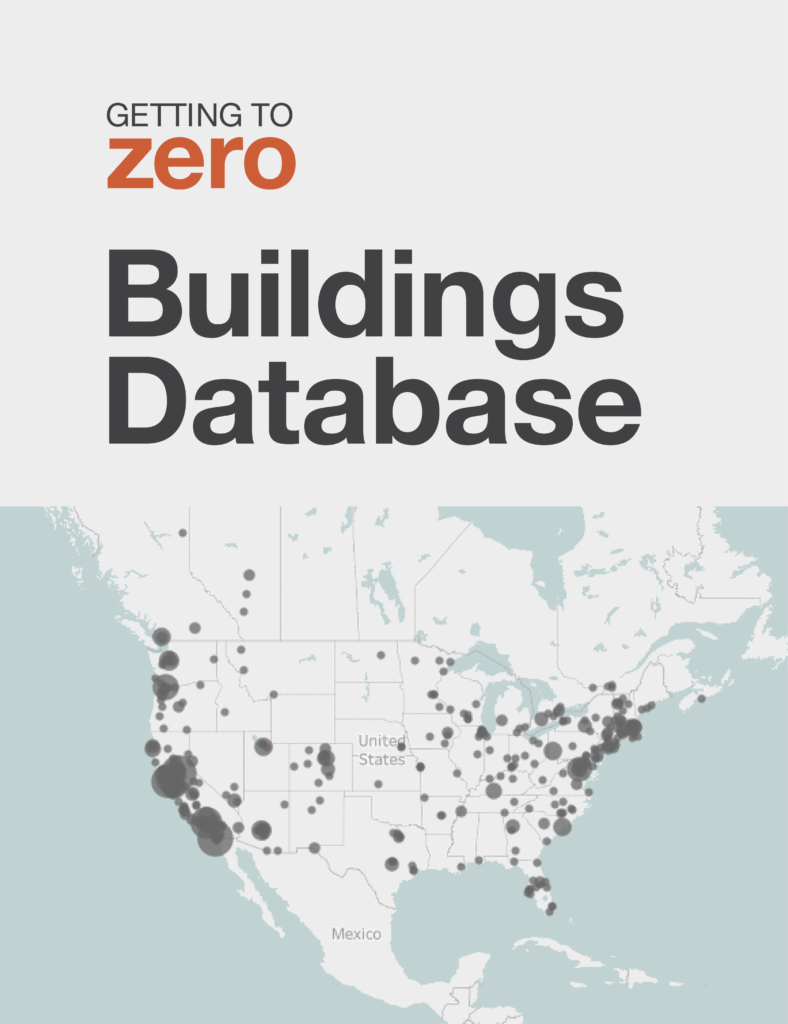
Getting to Zero Buildings Database
Online Tool / July 22, 2022
NBI works to identify, research, analyze, and promote commercial and multifamily buildings that are leaders in low and zero energy. We maintain the most comprehensive list of zero energy (ZE) commercial and multifamily buildings across North America. This interactive tool…
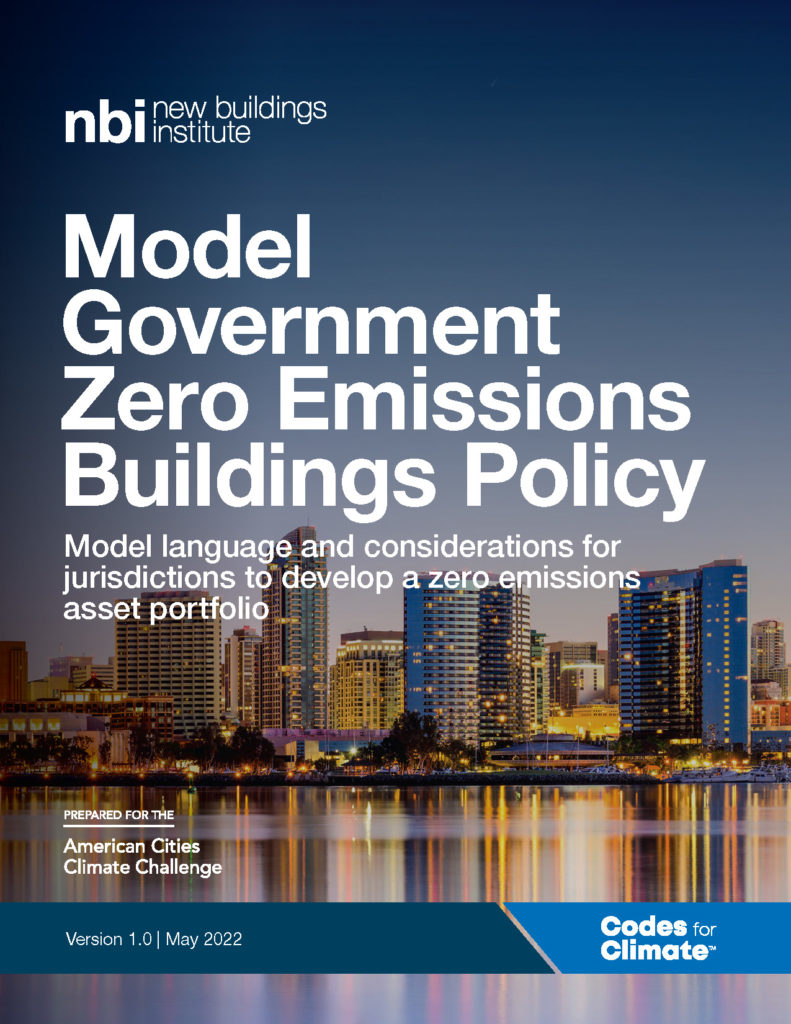
Model Government Zero Emissions Building Policy
Guideline / May 18, 2022
Released by New Buildings Institute, the Model Government Zero Emissions Buildings Policy provides plug-and-play policy language for jurisdictions considering taking a “lead by example” approach to building decarbonization. By using their own buildings to demonstrate how new technologies and operational…
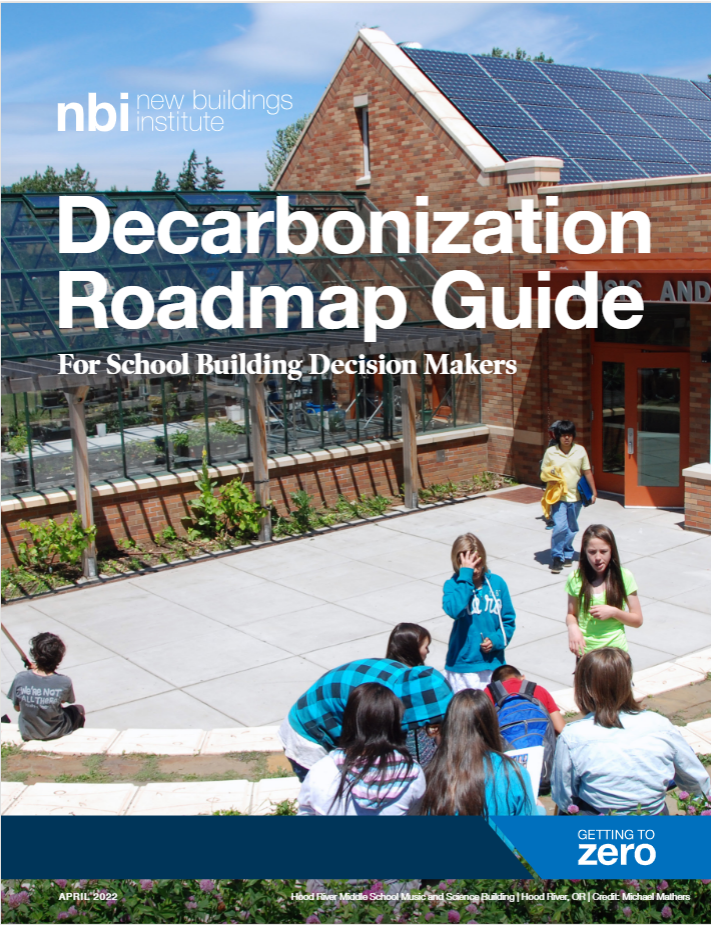
Decarbonization Roadmap Guide for School Building Decision Makers
Guideline / April 25, 2022
The Decarbonization Roadmap Guide is written for those interested in healthy, efficient, carbon neutral school design, construction and operation. It outlines achievable goals that result in healthy, affordable, all-electric facilities, and explains common actions taken by leading districts to operationalize…

Key Messages for Communicating About Carbon Neutral Schools
Guideline / April 13, 2022
Effective communication is critical to successfully engage your audience and ultimately achieve your goal of designing, constructing, and operating a zero energy (ZE) school. This document will help you to address key questions around your communication effort and engage stakeholders…
GridOptimal Measure Analysis Tool and Utility Programs Guidance
Online Tool / February 1, 2022
Energy efficiency strategies, or measures, can have impacts well beyond simply saving energy. The time of day and season of energy savings is increasingly important. This interactive tool enables you to explore the time-of-use implications of a variety of energy…
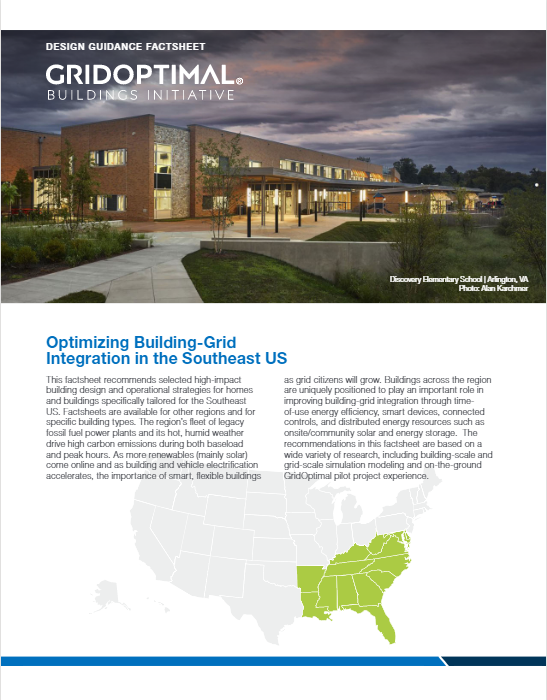
GridOptimal Design and Operations Guidance
Guideline / October 26, 2021
These easy-to-understand fact sheets are available for six building types and seven regions across the United States and provide key context and recommend selected high-impact building design and operations strategies. The GridOptimal Buildings Initiative aims to improve building-grid interactions across…

An Insider’s Guide to Talking about Carbon Neutral Buildings
Guideline / September 8, 2021
The Insider’s Guide to Talking About Carbon Neutral Buildings presents a common language and framework to align market ideas around what it means to design, construct, and operate buildings that contribute little or no carbon emissions. This document explains the…
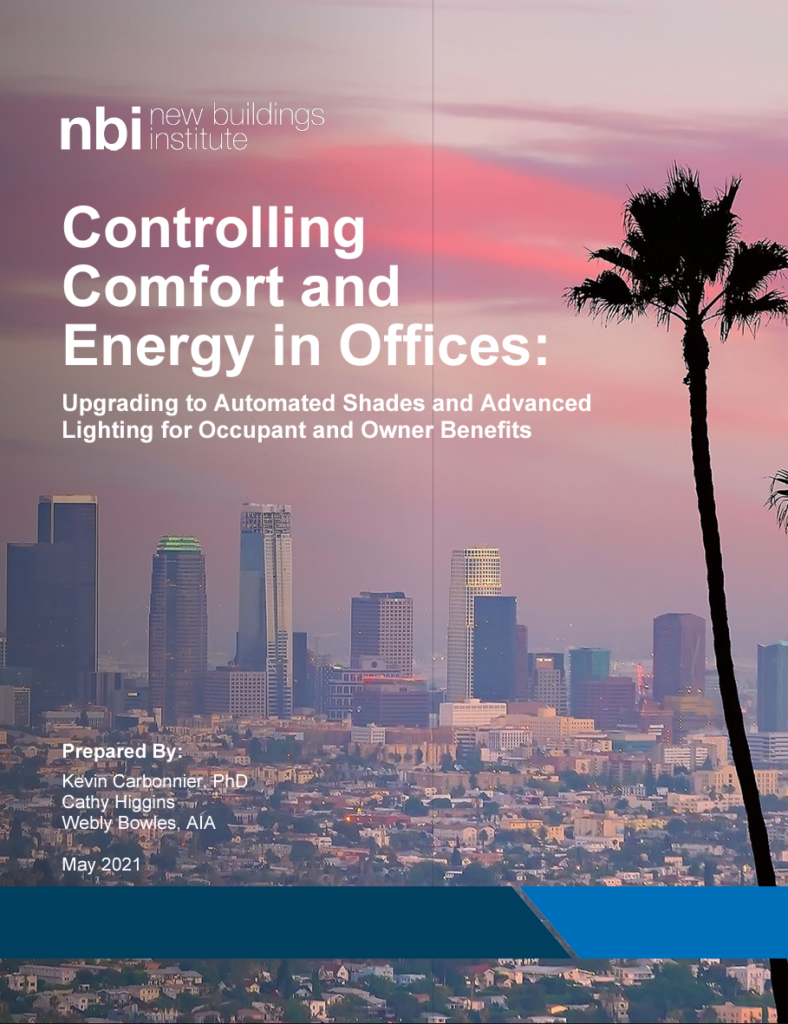
Controlling Comfort and Energy in Offices: Upgrading to Automated Shades and Advanced Lighting for Occupant and Owner Benefits
Guideline / August 27, 2021
Interior lighting and window shading innovations have advanced leaps and bounds in the past two decades. Each innovation offers benefits to existing buildings, ranging from improved occupant comfort and wellbeing to significant energy savings. Geared toward building owners and operators,…
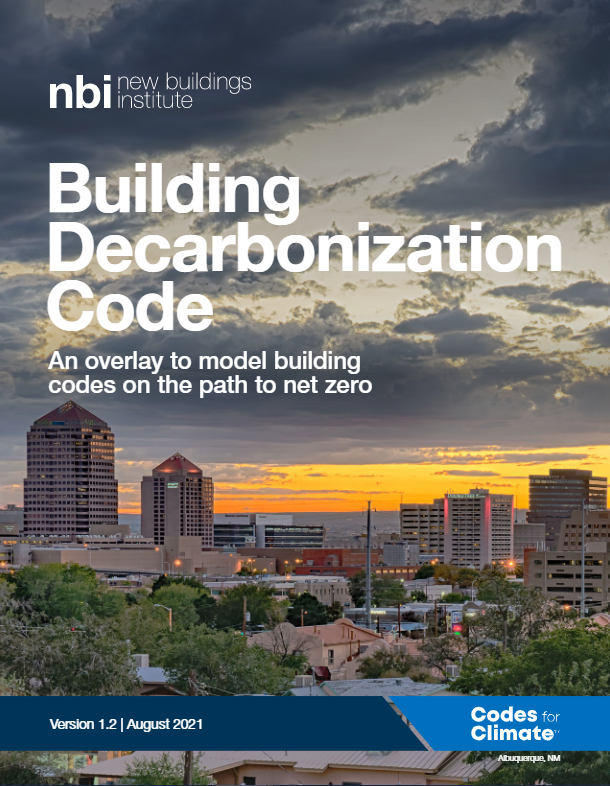
Building Decarbonization Code
Guideline / August 26, 2021 / Energy Codes
The Building Decarbonization Code is a groundbreaking tool aiming to deliver carbon neutral performance. The Version 1.2 code language from NBI serves as a building decarbonization overlay to the 2021 International Energy Conservation Code (IECC) and is now compatible with…
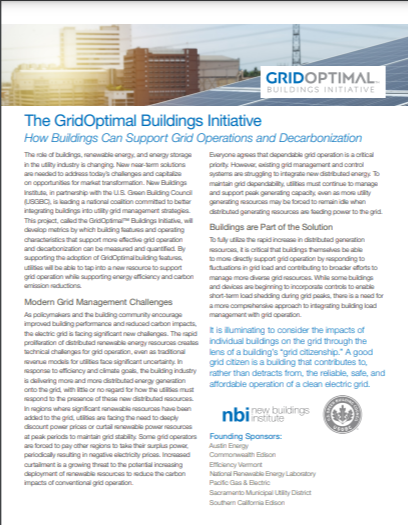
GridOptimal Factsheet
Factsheet / May 19, 2020
This factsheet outlines the key components of the GridOptimal Buildings Initiative and explains how buildings can support grid operation and decarbonization. Learn about the challenges of modern grid management, how buildings can be a part of the solution to support…
About NBI
Factsheet / December 7, 2019
With this printer friendly 2-page factsheet, learn more about how NBI is working to find strategic points of leverage that will deliver the best outcomes for improving building efficiency.
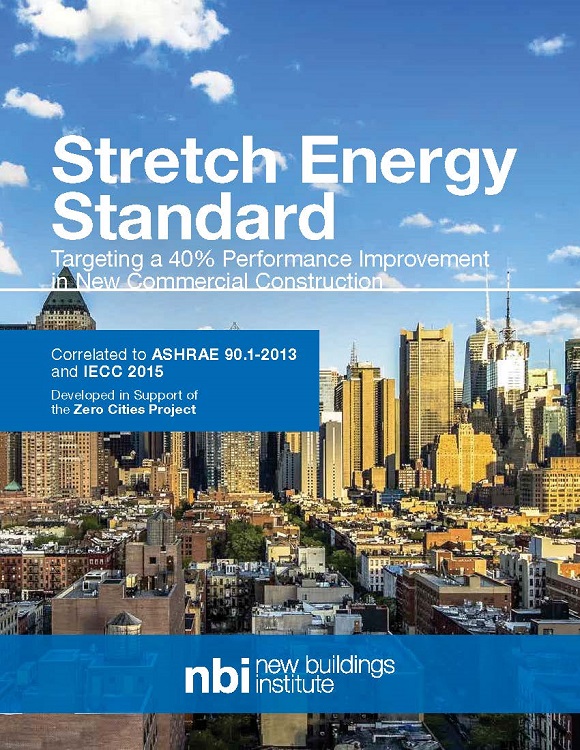
40% Stretch Energy Standard
Guideline / February 14, 2019
The 40% Stretch Energy Standard is a set of stretch code strategies that target 40% better efficiency in commercial buildings than current national model energy codes. Stretch codes, also called reach codes, provide an opportunity to introduce advanced practices in…
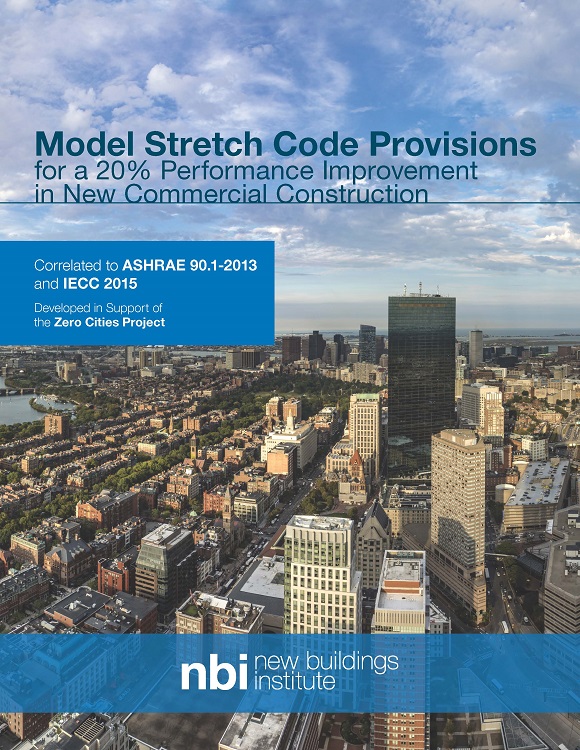
20% Stretch Code Provisions
Guideline / February 14, 2019
The 20% Stretch Code Provisions describe a set of code strategies that represent a 20% performance improvement for commercial buildings over the ASHRAE 90.1-2013 code baseline (and approximately similar savings over the IECC 2015 baseline) that can be adopted by…
FirstView
FirstView / October 15, 2018 / Benchmarking & Feedback
FirstView is a software tool that enables building owners and designers to extract more targeted and useful energy performance information from basic data inputs. The software takes in basic building data and one year’s energy usage and uses multivariable regression…
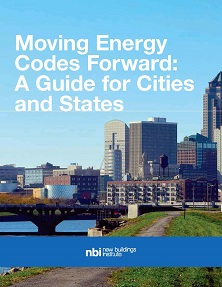
Moving Energy Codes Forward: A Guide for Cities and States
Guideline / June 4, 2018 / Energy Codes
In cities, the building sector is a major contributor to carbon emissions and energy use accounting for up to 40% of the total energy consumed. Some jurisdictions may have climate policies and climate action plans that set targets and lay…
Zero Energy Performance Index (zEPI) and zEPI Jurisdictional Scores
Online Tool / May 16, 2018 / Energy Codes
The Zero Energy Performance Index (zEPI) provides a scale for measuring commercial building energy performance and represents a fundamental shift in measurement of building efficiency as it sets energy targets for actual energy consumption rather than using a predictive energy…
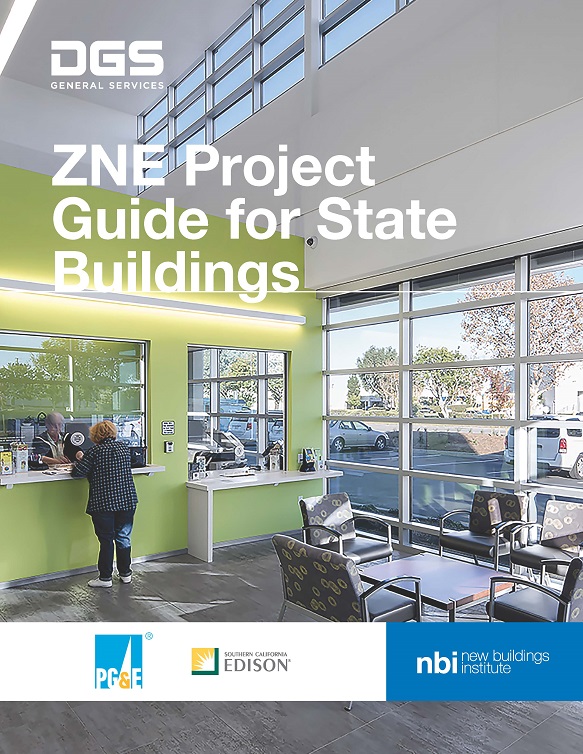
ZNE for State Buildings
Guideline / April 12, 2018
The ZNE Project Guide for State Buildings was created to provide California state agencies a step by step guide and checklist for pursuing zero net energy (ZNE) for new buildings. Project managers can use this resource to gain stakeholder support,…
Public Buildings Portfolio Management
Guideline / January 11, 2018 / Existing Buildings
Hundreds of Mayors across the United State have made formal commitments to the Paris Climate Accord. Others have signed onto the 2030 Challenge and/or the Better Buildings Challenge. To meet these goals, an effective strategy to track, manage, and improve…
Model Stretch Code Provisions for a 20% Performance Improvement in New Commercial Construction
Guideline / November 6, 2017 / Energy Codes
This summary document describes a set of code strategies that represent a 20% performance improvement for commercial buildings over the ASHRAE 90.1-2013 code baseline (and approximately similar savings over the IECC 2015 baseline).
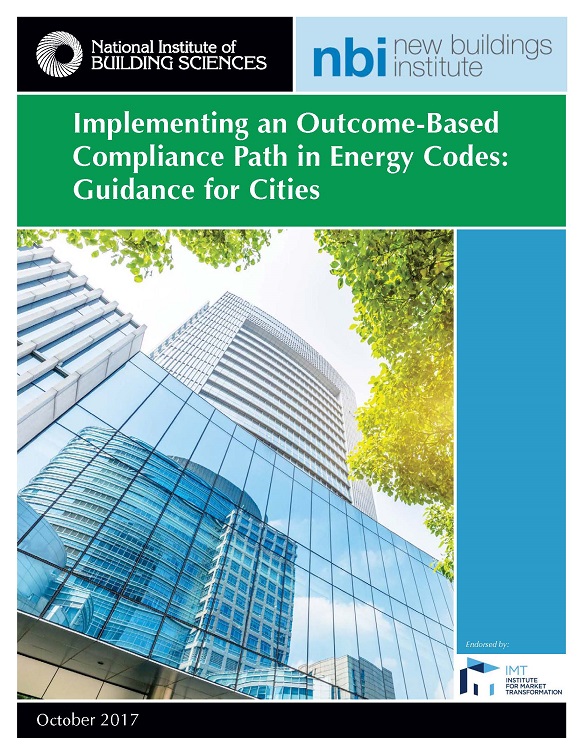
Outcome-Based Codes for Cities
Guideline / November 1, 2017
Adjustments and modifications to the built environment provide significant opportunities for meeting energy reduction goals and objectives, since buildings comprise 40% of our nation’s primary energy consumption. This document provides jurisdictions with a new approach to shift their focus towards…
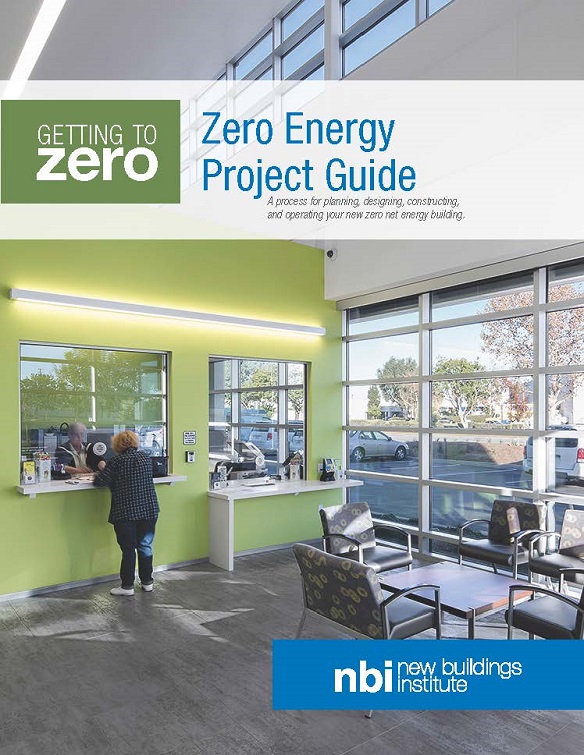
Zero Energy Project Guide
Guideline / October 11, 2017
A process for planning, designing, constructing, and operating your new zero energy building. Zero Energy Project Guide combines the steps that successful zero energy (ZE) building teams implement with ZE tools and resources. The guide outlines the importance of gaining…
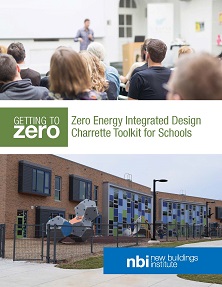
Zero Energy Schools Charrette Toolkit
Guideline / October 11, 2017
NBI’s Zero Energy Integrated Design Charrette Toolkit for Schools provides you with materials to help plan and lead a successful charrette for your school project. It can be used for almost any team aiming for high levels of energy efficiency…
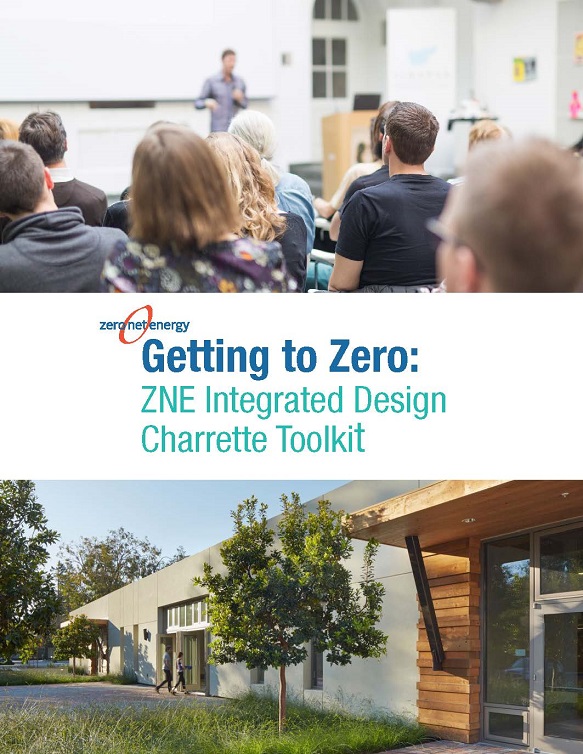
ZNE Charrette Toolkit
Guideline / October 4, 2017
NBI’s ZNE Charrette Toolkit provides you with materials to help plan and lead a successful charrette. It can be used for almost any team aiming for high levels of energy efficiency or sustainability whether actively pursuing ZNE or not. The…
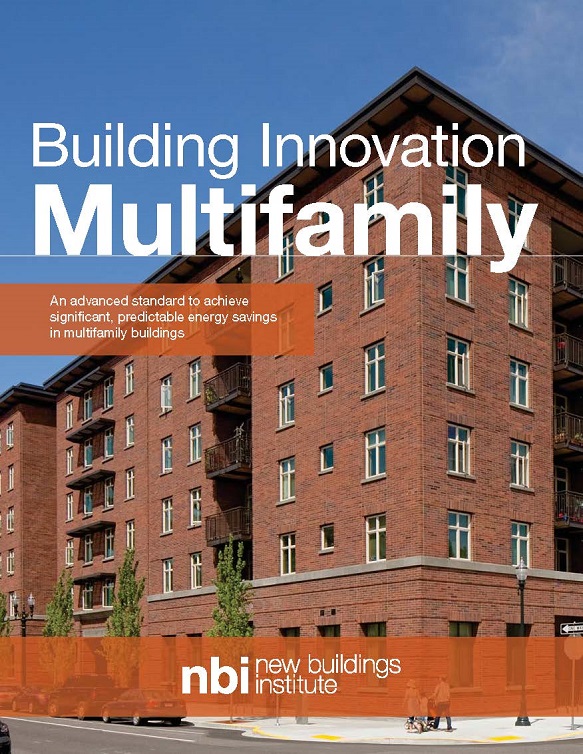
Multifamily Building Guide
Guideline / September 6, 2017
NBI's Multifamily Guide offers an advanced standard that addresses the issues faced when applying building code to multifamily buildings. This single prescriptive standard delivers savings regardless of whether the project is subject to the residential or commercial versions of the…
Getting to Zero: ZNE Project Guide
Guideline / August 30, 2017
Getting to Zero: ZNE Project Guide combines the steps that successful ZNE building teams implement with ZNE tools and resources. The guide outlines the importance of gaining stakeholder awareness, setting energy goals and targets, thoughtful team selection, finance and incentive…
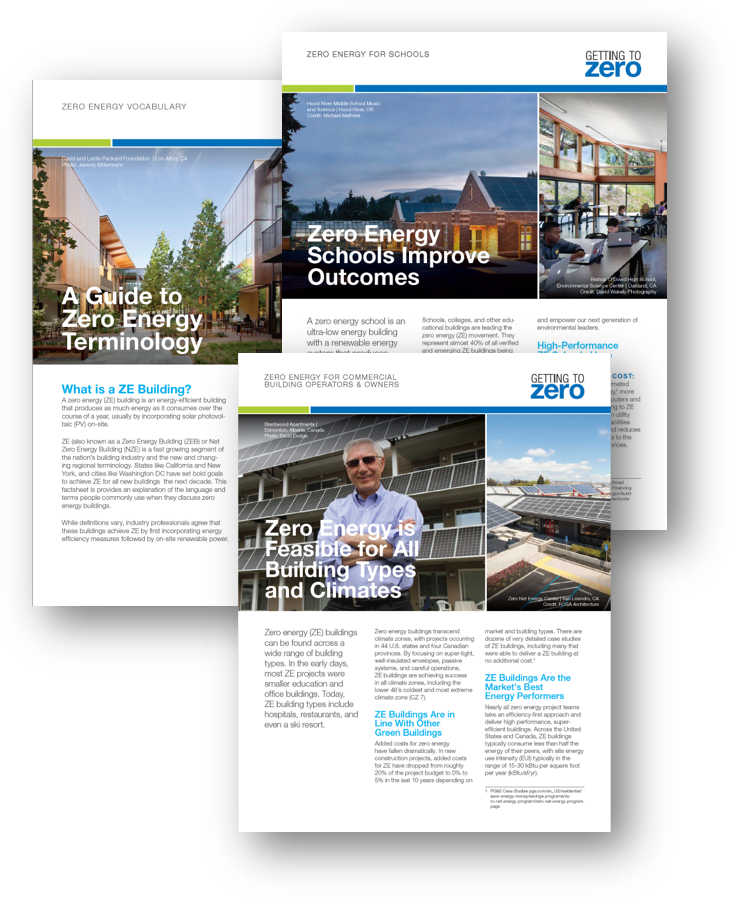
Zero Energy Communications Toolkit
Guideline / August 9, 2017
The conversation around zero energy (ZE) buildings is evolving with many different terms emerging to describe these recent developments. To support consistent and clear communications, New Buildings Institute (NBI) has developed a number of factsheets that early adopters and advocates…
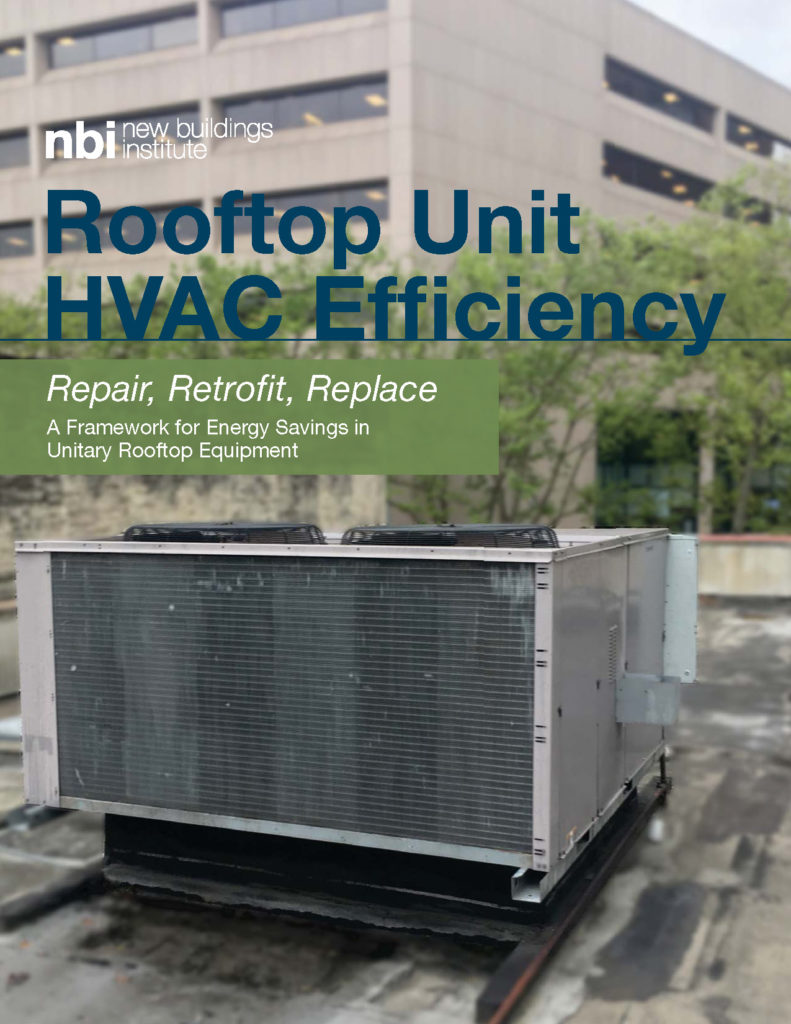
HVAC Primer
Guideline / June 14, 2017
This primer describes energy savings opportunities and context for packaged rooftop units (RTUs) for utility energy managers and their trade allies. RTUs are ubiquitous in commercial spaces but are also a difficult market to reach. Analysis shows many opportunities for…
Quantifying the Water-Energy Nexus at the Building Project Scale
Online Tool / June 1, 2017 / Water-Energy Nexus
NBI has laid the groundwork to connect the water-energy nexus at the power plant with the energy consumed at the building level. With the support of existing research and funding from the Edwards Mother Earth Foundation, NBI has created a…
SMARTScale
Online Tool / February 21, 2017 / Existing Buildings
Introducing SMARTScale... In 2014, the US Department of Energy (DOE) awarded a grant to NBI partner Ecology Action to create and demonstrate a nationally scalable model targeted to utility and public benefits efficiency program operators for delivering deep retrofits in…
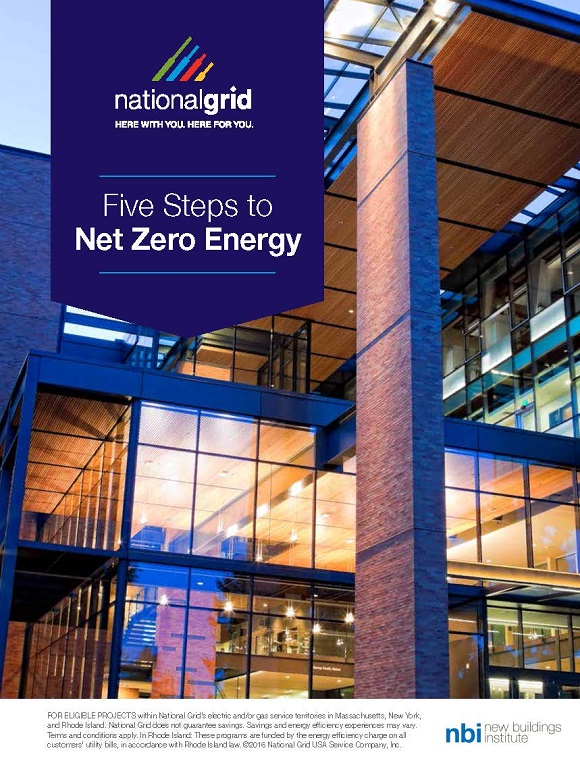
Five Steps to Net Zero
Guideline / February 2, 2017 / Zero Net Energy (ZNE)
This guide is an introduction to how architects and engineers can help clients upgrade their existing buildings to be ZNE through a Deep Energy Retrofit combined with renewable energy sources. A Deep Energy Retrofit is an existing building retrofit that…
Daylighting Pattern Guide
Online Tool / December 20, 2015 / Daylighting
The Daylighting Pattern Guide is a free, interactive tool that helps design teams incorporate proven daylighting strategies into commercial building projects for substantial reductions in lighting power consumption and overall building energy use.

HVAC Primer
Guideline / December 19, 2015 / HVAC
This newly updated primer describes energy savings opportunities and context for packaged rooftop units (RTUs) for utility energy managers and their trade allies. RTUs are ubiquitous in commercial spaces but are also a difficult market to reach. Analysis shows many…
COMNET
Guideline / December 19, 2015
COMNET is a quality assurance initiative to standardize building energy modeling, by creating consistent baselines relative to various energy codes and standards. COMNET extends and supports existing systems for assessing and rating the energy efficiency of new commercial and multifamily…
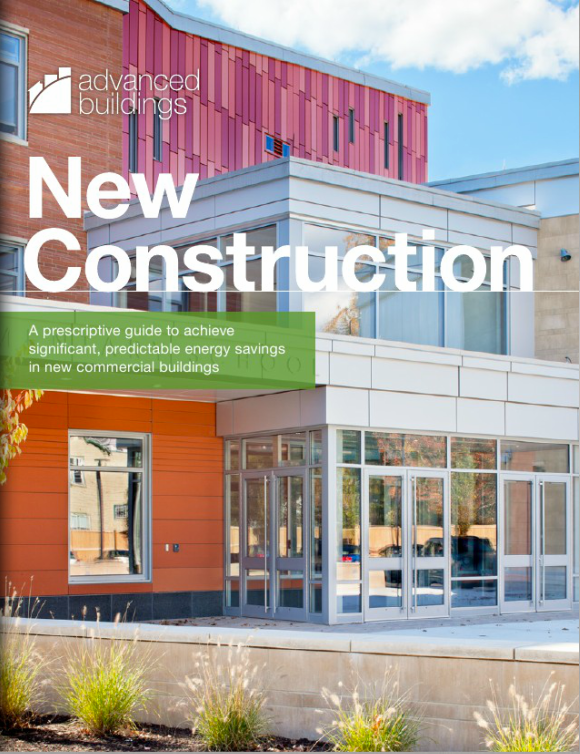
New Construction Guide
Guideline / December 12, 2015
Increasing energy code stringency and owner demand for higher efficiency in buildings are challenging design teams to deliver high performance without adding costs. The New Construction Guide offers a comprehensive prescriptive approach to new commercial construction projects that achieves efficiencies…
Zero Net Energy Technology Application Guide: Radiant Heating And Cooling + Dedicated Outdoor Air Systems
Guideline / November 4, 2014
Zero Net Energy (ZNE) is the future, and in a growing number of places the present, of building design and energy policy. A growing strategy to get to ZNE is to separate the building’s heating/cooling from the ventilation/dehumidification. This guide…
Zero Net Energy Technology Application Guide: Luminaire Level Lighting Control
Guideline / November 4, 2014
Improved lighting efficiency has long been a major strategy to reduce the energy use in buildings. These savings have traditionally come from improved efficiency of lamps and ballasts. Today, deep energy reductions and Zero Net Energy (ZNE) are possible by…
Zero Net Energy Technology Application Guide: Indirect Evaporative Cooling
Guideline / November 3, 2014
With Zero Net Energy (ZNE) a growing building design and energy policy trend, design firms and owners are striving to meet heating, ventilation and air conditioning (HVAC) loads with optimum comfort and minimal energy. Indirect Evaporative Cooling (IEC) offers a…
FirstView for Multifamily Buildings
Online Tool / May 27, 2014
Multifamily buildings offer a largely untapped opportunity for improving energy efficiency. Despite tremendous potential for savings, the multifamily market is hard to penetrate due to complexities in market structure and split incentives. More and more attention is being paid to…
Core Performance Provides a Path to High Performance Buildings
Guideline / February 28, 2013
The Core Performance Guide is a prescriptive path that was first published in 2007. Following this building guidance will result in buildings that are more energy efficient than conventional buildings.
About New Buildings Institute (NBI)
Guideline / February 27, 2013
New Buildings Institute (NBI) is a nonprofit organization working to improve the energy performance of commercial buildings. Learn more in this print friendly factsheet.
Plug Load Best Practices Guide
Guideline / July 17, 2012
The Plug Load Best Practices Guide outlines no-cost and low-cost measures for reducing the energy and costs associated with plug loads, or any device that is plugged into a building’s electrical system—think computers, printers and data servers. The guide, based…
Core Performance Guide
Guideline / January 27, 2012
The Core Performance Guide is a prescriptive path was first published in 2007. The Core Performance Guide offered a prescriptive approach to achieving high levels of energy efficiency above contemporary energy codes. It was also included in previous versions of…
